#fitness evolution laurel
Text
Two
Dangerously, through a field of rubbery grass, chased Hughes after a sunset which would never fall and the girl eclipsing it who already had. Foot trod purple mouths of tubular flora; smooching at swarms of plump bumblebees bouncing through the powdery sky. So fell the kisses to earth and ululated the loamy soil with their viral tongues. Ribbons of silk, black hair played on the sky in eager jumps as if guffawing tides in the middle of a jovial ocean. And the calluses first reached out, then the hand toward loose strands which fell from the girl's scalp like the wandering fluff of a blown dandelion. And the sun swallowed her shadow.
Remnants of a bruise-purple sky pulsed in splotches of blue soaking them and the tides rose to swallow the rock but fell like breathing as the moon called them home. And midnight-quiet went the field, its asphyxiating whispers weren’t even a nod in the air and the depth of the silence was incomprehensible; itching at and numbing the ears. Thoughts couldn’t even muster space in the mind of Hughes who was slowly becoming entirely blank, without even the awareness to continue breathing. So succumbed to his dulling mind and shrank away from the reality of sensation, Hughes liquified entirely.
Sloshed and frothed in an ebbing decanter; oxides and tannins losing their tangibility, ultimately falling into alcoholic sulfites to be vinted and bottled in Modesto, California. Whiffs of black cherry and a hint of vanilla find themselves etched into the thunderstruck somalia who must alert the National Foundation of Rescued Wine. They would certainly be gobsmacked at his latest discovery, a wine with not one, but two notes.
“It’s bullshit!” He bellows into the now open halls of the foundation. “It’s all bullshit!” And is. Soon crumbled the foundation of the foundation which had been held together for centuries on an air-tight laurel of, never let them see you sweat. But condensation was finally possible (and superfluous) as the temperature rose dramatically without pretext. The ice on gilded fly’s wings melted and fell in opalescent puddles of motor lunch. And Alcoholics Anonymous meetings were held in the bright rays of the sun which spilled through the membranes of thinning clouds and greeted the land with abundant warmth.
Soon enough there was a lucrative prospect in accommodating the inclimate weather. The death of their eyes transmuted into welcoming blues, greens, and hazels. Gnats were welcomed back to the earth, burrowing into the silicone flesh of garden vegetables and made homes in the melting walls of their juicy rinds. Swarming in loud buzzes over the deserts made in states of rising sand compelled by the sun. The people learned to keep themselves cool by using their abundant salivation on the areas of the body which lose heat the fastest. Teeth turned spongy after over intoxication on hydration but allowed mouths to hold deposits of water like reservoirs deep in the earth.
Tongue met asshole and found it fit between spread buttcheeks like the continents as Pangea. Dug their tongues through the sweating walls of prolapsing intestine and cooled the area with a flex of their tongues. Steam rose from open mouths in a train's exhale of cloudy exhaust. Saunas became extinct in favor of sunbathing and one became their own coals with their tongue the ample source of liquid for another and linked themselves in a perpetually satisfied chain of refreshment and exhaust. But slowly, so slowly it was like evolution, were peoples’ broiling their insides, ready to be served with gravy for thanksgiving dinner!
Colonies fell into a state of humid frying. Unable to communicate with each other in their roast-turkey'd states. So began the success of the common fly and its dominance as one of earth's greatest predators. While citizens collapsed with rectal abandon, so thrived the festering fly. Its prey had become a millionth of its size in a direction no scientist or paranoid junky or trembling pervert could have predicted. They ate cooked human meat (which could’ve used a little salt) for every meal for millions of years. Gone were the times of 28 day lifespans and what ushered forth was a glorious respite in rectitude of the fly.
#bugginoutofthisworld#fiction#writeblr#writers of tumblr#creative writing#short story#queer writers#writers on tumblr
4 notes
·
View notes
Text
Butch Walker – Letters
I think I’d been waiting for it.
Butch Walker released Letters, his second full-length album as a solo artist, on August 24, 2004, two weeks before I started eighth grade. At the time, I was right in the middle of a burgeoning obsession with soundtracking every moment of my life. Music had always mattered to me, but something had clicked during the previous school year and songs had taken on a different level of meaning for me since then. Before, I maybe just liked the way something sounded on the radio. Now, I was falling in love with the way those songs could encapsulate the rhythms of my days and nights. I figured: if movies and TV shows had soundtracks, why shouldn’t my life have one too? And so I’d spent months making mixes for everything: for the end of seventh grade, for my summer vacation, for my family’s annual summer road trip to visit my grandparents in New Hampshire, and for the impending end of the season and all the bittersweet emotions that made me feel.
What I hadn’t done yet was make a mix for a girl. I wasn’t too familiar with the concept of mixtapes – with what a collection of songs could mean when you picked the tracks and sequenced them and packaged them for someone you felt romantic feelings for. Surely, I would have found my way to the art of mixtape-ology no matter what, as all music fans do. How long can you obsess over using music to encapsulate your own internal life before you start thinking about how music can play the role of confessional love note? Probably not long. Before I could get there on my own, though, I found my Jedi Master on the subject of mixtapes, and it changed my entire life.
“You gave me the best mixtape I have/And even all the bad songs ain’t so bad.” So goes the chorus to “Mixtape,” the lead single from Letters and the first song I ever heard Butch Walker sing. It’s surreal to look back on that first listen, knowing now that it was my first interaction to the guy who would become my favorite artist of all time. But then again, it’s also fitting that it was “Mixtape” that opened up a whole new doorway in my musical evolution, given what that song has to say. Because “Mixtape” is a song about the way music obsessives think about crushes or love stories: where maybe you can’t quite find the words to say how you really feel about someone, but your favorite band can.
This weekend marks 20 years since the release of Letters, and in that time, I have made a lot of “mixtapes” for a lot of girls. Some of them I’ve given to the people they were meant for; some of them only ever existed on my computer hard drive or my iPod – little fantasy versions of things I wished I’d said. I’ve made a lot of mixtapes for myself, too: Mixes to remember long-gone years of my life; mixes to commemorate summers I loved; mixes for specific days that felt like they deserved a curated soundtrack of significant import. Every time I make a mix, I think about Butch Walker and “Mixtape,” and about the rules the song sets down. Are the “bad” songs too bad? Are the sad songs too sad? “Mixtape” is the song that made me take my growing fascination with the emotional colors of music and use it as a means for expressing who I was and what I cared about.
Letters itself is like a perfect mixtape. It’s a collision of different moods and influences and stories and snapshots of life. The tracklist veers from power-pop heartache (proper opener “Maybe It’s Just Me”) to Laurel Canyon sundowns (“So At Last”), and from bare-as-hell piano ballads (“Joan”) to epic guitar pyrotechnics (“Lights Out”). You can almost feel Butch mixing the tape in the background: a song that sounds like Jackson Browne here, a song that sounds like U2 there; a celebratory summer anthem at track 4, a crushing breakup ballad at track 10. Along the way, he sketches a story about love and heartbreak; about falling in love with a city and then realizing that you have to get the hell out of that city for the sake of your health and your sanity; of life and what it means to write your own… https://chorus.fm/reviews/butch-walker-letters-3/
0 notes
Text
The modern barong Tagalog is a contemporary evolution of the traditional Filipino garment, combining classic elements with current fashion trends. Here’s an overview of what makes the modern barong Tagalog distinctive:

Key Features of the Modern Barong Tagalog
Fabric and Materials:
Diverse Fabrics: While traditional barongs are made from piña (pineapple fiber) or jusi (a type of silk), modern versions might use a range of materials such as synthetic fibers, cotton blends, or even high-tech fabrics that offer improved durability and comfort.
Comfort and Breathability: Modern materials are often chosen for their comfort, breathability, and ease of maintenance, making the barong suitable for various occasions and climates.
Design Innovations:
Color Variations: Unlike the classic white or cream barong, modern versions come in a wide array of colors. These vibrant shades can range from bold hues to subtle pastels, allowing for more personal expression.
Patterns and Embroidery: Contemporary barongs might feature innovative patterns and embroidery, including geometric designs, abstract art, or even fusion styles that blend traditional motifs with modern aesthetics.
Tailoring and Fit:
Slim and Tailored Cuts: Modern barongs often have a slimmer, more tailored fit compared to their traditional counterparts. This change caters to contemporary fashion preferences and provides a more streamlined silhouette.
Customization: Many designers offer customization options, allowing individuals to personalize their barongs with unique designs, colors, and fits.
Occasions and Versatility:
Casual to Formal: The modern barong Tagalog is versatile and can be worn for a range of occasions. It’s suitable for formal events like weddings and official functions, as well as more casual settings or cultural celebrations.
Day-to-Night Wear: The versatility of the modern barong allows it to transition from day to night, adapting to various dress codes and events.
Fashion Integration:
Pairing with Modern Wear: Modern barongs are often styled with contemporary fashion pieces, such as tailored trousers, loafers, or even sneakers, bridging traditional Filipino attire with global fashion trends.
Innovative Styling: Fashion designers sometimes incorporate elements from other global fashion trends, creating a hybrid look that resonates with both local and international audiences.
Sustainability and Ethical Production:
Eco-Friendly Materials: Some modern barong Tagalogs are made from sustainable or eco-friendly materials, reflecting a growing trend towards responsible fashion practices.
Ethical Production: Emphasis on ethical production practices is becoming more prevalent, with a focus on fair labor practices and local craftsmanship.
Notable Designers and Brands
Rajo Laurel: Known for integrating traditional Filipino elements with modern fashion, creating barongs that are both stylish and contemporary.
Francis Libiran: Renowned for his luxurious and innovative designs that often include modern twists on traditional attire.
Randy Ortiz: Offers modern takes on traditional garments with attention to detail and contemporary styling.
The modern barong Tagalog represents a dynamic blend of tradition and innovation, reflecting the evolving nature of Filipino fashion while preserving its cultural significance. Whether for formal events or casual outings, the modern barong Tagalog provides a stylish and adaptable option for contemporary wardrobes.
#barong tagalog#philippines#barong#pinoy#philippines fashion#barongtagalog#barongtagalogforwomen#womensfashion#shopping#barongs
0 notes
Text
Unveiling the UX Secrets of Popular Apps: What Makes Them Tick?
In the ever-evolving landscape of digital experiences, user interface (UI) and user experience (UX) design have become critical factors in determining the success of mobile applications. From seamless navigation to visually appealing interfaces, popular apps seem to have cracked the code for engaging and retaining users. In this exploration, we unravel the UX secrets behind some of the most beloved apps, shedding light on the elements that make them tick.
The Power of Intuitive Design
At the heart of exceptional UX lies the principle of intuitive design. Apps like Instagram and Snapchat have mastered the art of simplicity. Their user interfaces are streamlined, offering a straightforward and easily understandable experience. Icons and buttons are strategically placed, ensuring users can effortlessly navigate through the app without feeling overwhelmed.
Personalization: Tailoring the Experience
Personalization is a key ingredient in the success of apps such as Spotify and Netflix. These platforms go beyond the one-size-fits-all approach, leveraging algorithms to curate content based on individual preferences. By providing personalized recommendations and content, these apps create a sense of connection with users, making them more likely to stick around for the long haul.
Seamless Onboarding: A First Impression That Lasts
First impressions matter, especially in the world of mobile apps. Successful apps invest in creating seamless onboarding experiences to hook users from the start. Take TikTok, for instance, with its quick and interactive onboarding process that immediately immerses users in the app's unique video-sharing experience. By minimizing friction during the initial interaction, these apps ensure users are more likely to explore further.
Consistency Across Platforms
Maintaining consistency across different platforms is another secret weapon in the UX arsenal. Apps like Google Drive and Dropbox seamlessly transition from desktop to mobile, ensuring a consistent look and feel. This not only contributes to a smoother user experience but also enhances user trust in the reliability of the application.
Feedback Loops: Engaging Users in the Experience
Feedback loops are crucial for user engagement and satisfaction. Apps like Duolingo and Headspace excel in this aspect by providing real-time feedback and positive reinforcement. Whether it's language learning achievements or meditation streaks, these apps use feedback to motivate users, turning the learning process into a rewarding experience.
Accessibility: Inclusive Design for All
An often overlooked but essential aspect of UX is accessibility. Apps like Microsoft Teams and WhatsApp prioritize inclusive design by ensuring their interfaces are accessible to users with disabilities. From screen reader compatibility to customizable text sizes, these apps make an effort to include all users, recognizing the diverse needs of their audience.
Continuous Evolution: Adapting to User Needs
The most successful apps don't rest on their laurels. They continuously evolve based on user feedback and changing trends. Updates from social media giants like Facebook and Twitter are driven by user preferences and emerging technologies. This commitment to staying relevant ensures that the user experience remains fresh and aligned with evolving expectations.
In conclusion, the UX secrets of popular apps go beyond flashy visuals and catchy features. Intuitive design, personalization, seamless onboarding, platform consistency, feedback loops, accessibility, and continuous evolution are the pillars that support a memorable and engaging user experience. By understanding and incorporating these principles, aspiring app developers can unlock the potential to create the next big thing in the digital realm.
Visit my Upwork profile for - UI/UX design, Mobile Design & Product Designer
Project Catalog for - Mobile App UI UX Design, iOS or Android Mobile APP UX/UI Design & Modern Crypto Design
1 note
·
View note
Text
Music Update
The other music update was from my twitter and I want to put it here because I was proud.

loveless by my bloody valentine I'm pretty sure is like the album I would point to as the most twitter thing. I've listened to before and I'm sure most of you have, but this was another instance where I decided to actively listen to it, which I feel speaks to musical evolution. It has this lo-fi, vibrant, hazy, shimmering quality to it thats not really easily replicated. The general melodies and rhythms are simple but vibing and catchy and flow very well throughout. So it's the perfect album to like sit and listen to. There's also enough variety in presentation, like I Only Said sounds like, a tad country or something whereas Blown A Wish is dreamy. I include this in here as I think is stylistically fits in with all the others I wanted to mention.

Hellfire by black midi is very frantic. I actually listened to this in the same batch as the others but I didn't write about it there and so my thoughts I collect in this batch here. It's once again a very creative blend of all kinds of styles done in a fair bit of a showy frantic way, in particular huge jazz emphasis. A good portion of the vocals feel like idk something of a horse racer commentator. It's a name I didn't check out for a while simply because the artist name made me expect something like noise music. After first listen I don't think it caught me as much as say Thank You Scientist on the whole did in elements of each part clearly sticking out on something in the coherent whole but still very good.

Quarantine by Laurel Halo was one I wanted to check out sheerly because of this album cover. Look at this. It's so fucking badass. It's this ambient ethereal type piece with this really cool sound and making heavy use of these airy vocals that in another sense can come off harsh and flat (as was particularly the case on the track Years). I'm not sure I per se found as much to latch onto but I also feel like its one I'll revisit as a stepping stone towards other stuff in this vein. It's a very relaxing and distinctive feeling type piece. Like an indie approach to ambient melodies of Aphex Twin and u-Ziq I'm more used too.

Then Breakup Song by Deerhoof came up in the autoplay and there and then I decided this would be another good album to check out. It once again fits in the 'ease of listen but experimental' zone. Like a miss of indie rock, electronic, noises, and shoegaze. It's good to know this kind of sonic landscape is one that exists and things don't have to be 'boxed in' towards one or two genres.
1 note
·
View note
Link
A track-by-track breakdown of the singer’s joyous, expansive new album
Harry Styles twirls in the center of the floor of the L.A. Forum, dancing wildly to his new song “Golden.” The venue is deserted. It’s Thursday afternoon, just a few hours before the release of his hotly awaited second album, Fine Line. He’s rehearsing for Friday night’s big album-release celebration show. (Outside the arena, the parking lot is full of tents—fans from around the world have been camping out all week, awaiting a spot on this floor.) After a few hours of rehearsing with his band, Harry cuts loose as the new album begins to blast over the speakers, breaking into a dance of joy. It’s probably the last time he’ll ever hear this song in a room where nobody else is dancing.
Backstage, he lounges on a leather couch in his corduroy flares, a string of pearls and a yellow T-shirt depicting a panda and the words “I’m Gonna Die Lonely.” He and his musical wingman, Tom “Kid Harpoon” Hull, argue over the set list for the upcoming world tour, even though it doesn’t start until April. His mother reaches for an apple; ever the dutiful rock-star son, Harry directs her to the bowl where the tastier apples are hidden. He’s restless with anticipation for the world to hear his new songs, and he’s not doing a great job of hiding it.
Fine Line is the soulful, expansive, joyous pop masterpiece Harry’s been reaching for ever since he blew up nearly ten years ago, as the heart-throb of One Direction. As he sings in “Lights Up,” the single that dropped in September, he’s stepping into the light. “It all just comes down to I’m having more fun, I guess,” he says. “I think ‘Lights Up’ came at the end of a long period of self-reflection, self-acceptance,” he says. “Through the two years of making the record I went through a lot of personal changes—I just had the conversations with myself that you don’t always have. And I just feel more comfortable being myself.”
His life has changed in oh so many ways—some involving the occasional magic mushroom, others involving the even more psychedelic power of a broken heart. The music ranges from the Laurel Canyon hippie soft-rock vibe of “Canyon Moon”—Harry calls it “Crosby, Stills and Nash on steroids”—to the R&B pulse of “Adore You.” Fine Line is a break-up album that’s often sorrowful, but reflecting the introspective evolution of a 25-year-old navigating the seas of Having Sex and Feeling Sad, despite having spent so much of his youth in the spotlight. He’s refusing to follow trends or fit any formula. “The overall arc is just that I tried to redefine what success means to me. I tried to rewire what I thought about it. A lot changes in two years, especially after coming out of the band and just working out what life is now. I feel so much freer, making this album—you get to a place where you feel happy even if the song is about the time when you weren’t that happy.”
The first time Harry played this album for me, back in June, it was a few miles away in L.A.’s Henson Studios, the same room where his idol Carole King made Tapestry—for him, sacred ground. “I look back on the last album,” he said then, referring to his 2017 solo debut. “And I thought I was being so honest, just because there’s one line about having a wank. I had no idea. You write a song that’s pretty open and honest, and you think that’s just my song, but then you hand it over to people, and it’s like, ‘Oh fuck!’ Until people hear them, they’re not even songs. They’re just voice notes.”
192 notes
·
View notes
Link
Harry Styles twirls in the center of the floor of the L.A. Forum, dancing wildly to his new song “Golden.” The venue is deserted. It’s Thursday afternoon, just a few hours before the release of his hotly awaited second album, Fine Line. He’s rehearsing for Friday night’s big album-release celebration show. (Outside the arena, the parking lot is full of tents—fans from around the world have been camping out all week, awaiting a spot on this floor.) After a few hours of rehearsing with his band, Harry cuts loose as the new album begins to blast over the speakers, breaking into a dance of joy. It’s probably the last time he’ll ever hear this song in a room where nobody else is dancing.
Backstage, he lounges on a leather couch in his corduroy flares, a string of pearls and a yellow T-shirt depicting a panda and the words “I’m Gonna Die Lonely.” He and his musical wingman, Tom “Kid Harpoon” Hull, argue over the set list for the upcoming world tour, even though it doesn’t start until April. His mother reaches for an apple; ever the dutiful rock-star son, Harry directs her to the bowl where the tastier apples are hidden. He’s restless with anticipation for the world to hear his new songs, and he’s not doing a great job of hiding it.
Fine Line is the soulful, expansive, joyous pop masterpiece Harry’s been reaching for ever since he blew up nearly ten years ago, as the heart-throb of One Direction. As he sings in “Lights Up,” the single that dropped in September, he’s stepping into the light. “It all just comes down to I’m having more fun, I guess,” he says. “I think ‘Lights Up’ came at the end of a long period of self-reflection, self-acceptance,” he says. “Through the two years of making the record I went through a lot of personal changes—I just had the conversations with myself that you don’t always have. And I just feel more comfortable being myself.”
His life has changed in oh so many ways—some involving the occasional magic mushroom, others involving the even more psychedelic power of a broken heart. The music ranges from the Laurel Canyon hippie soft-rock vibe of “Canyon Moon”—Harry calls it “Crosby, Stills and Nash on steroids”—to the R&B pulse of “Adore You.” Fine Line is a break-up album that’s often sorrowful, but reflecting the introspective evolution of a 25-year-old navigating the seas of Having Sex and Feeling Sad, despite having spent so much of his youth in the spotlight. He’s refusing to follow trends or fit any formula. “The overall arc is just that I tried to redefine what success means to me. I tried to rewire what I thought about it. A lot changes in two years, especially after coming out of the band and just working out what life is now. I feel so much freer, making this album—you get to a place where you feel happy even if the song is about the time when you weren’t that happy.”
The first time Harry played this album for me, back in June, it was a few miles away in L.A.’s Henson Studios, the same room where his idol Carole King made Tapestry—for him, sacred ground. “I look back on the last album,” he said then, referring to his 2017 solo debut. “And I thought I was being so honest, just because there’s one line about having a wank. I had no idea. You write a song that’s pretty open and honest, and you think that’s just my song, but then you hand it over to people, and it’s like, ‘Oh fuck!’ Until people hear them, they’re not even songs. They’re just voice notes.”
Here is Harry’s song-by-song guide to Fine Line—along the creative and emotional journey he took while making it.
“Golden”
The first song written for Fine Line, on the second day of the sessions at Shangri-La Studios in Malibu. “That was always the first one I played to people,” he says. “That was just always going to be Track One.” It’s a blast of vintage Seventies SoCal soft-rock, the kind of Laurel Canyon mellowness that suffused his first album, layered in guitars and harmonies. “When we wrote ‘Golden,’ we were sitting around the kitchen in the studio, and I was playing it on guitar. There were five of us singing the harmonies—the acoustics in the kitchen made it sound so cool, so we thought, this song’s gonna work.”
Even in this sunny SoCal pop tune, there’s a tinge of bittersweet loss—as the sun goes down, he pleads, “I don’t wanna be alone.” As he says, “I don’t know much about Van Morrison’s life—but I know how he felt about this girl, because he put it in a song. So I like working the same way.”
“Watermelon Sugar”
Harry did this fruit-crazed jam on Saturday Night Live, stretching out with his live band. He wrote “Watermelon Sugar” with producer Tyler Johnson, Tom Hull and guitar sidekick Mitch Rowland; as with the whole album, he worked with members of his tight rotating cast of friends and collaborators, rather than the usual hit squad of pros. “If you’re going in with session writers or something, you spend one or two days there, and there is no way that person really cares about your album as much as you do. Because they’re into something else tomorrow. I know that Mitch, Tyler, Tom, Sammy [Witte], Jeff [Bhasker] wanted the album to be as good as I wanted to be. They don’t care about if it’s their song or not. They’re not concerned how many songs they get on an album. They want it to be the best album it can possibly be. We’ll bond over music we love and things we’re going through. It’s not like there’s one person in the group that’s like, ‘Well, no, I don’t talk about that. I just make beats.’”
A massive influence on the album—and on his life—is his experience on his first solo tour, stepping out without One Direction. “The tour, that affected me deeply. It really changed me emotionally. Having people come to sing the songs. For me the tour was the biggest thing in terms of being more accepting of myself, I think. I kept thinking, ‘Oh wow, they really want me to be myself. And be out and do it.’ That’s the thing I’m most thankful for, of touring. The fans in the room is this environment where people come to feel like they can be themselves. There’s nothing that makes me feel more myself than to be in this whole room of people. It made me realize people want to see me experiment and have fun. Nobody wants to see you fake it.”
“Adore You”
“‘Adore You’ is the poppiest song on the album,” he says of the latest single. “This time I really felt so much less afraid to write fun pop songs. It had to do with the whole thing of being on tour and feeling accepted. I listen to stuff like Harry Nilsson and Paul Simon and Van Morrison, and I think, well, Van Morrison has ‘Brown Eyed Girl’ and Nilsson has ‘Coconut.’ Bowie has ‘Let’s Dance.’ The fun stuff is important.”
“Lights Up”
After kicking off his solo career with “Sign of the Times,” a sprawling glam-rock piano epic, Harry surprised many fans with his first single from Fine Line: a succinct, sleek R&B groove. “When I played it for the label, I told them, this is the first single. It’s two minutes thirty-five. You’re welcome.” It came late in the sessions—“Lights Up,” “Treat People with Kindness” and “Adore You” were written in the final week this spring, in a burst of inspiration.
For Harry it has something to do with stepping out on his own. When he began songwriting, it was as a member of the group. “‘Happily,” that was the first time I saw my name in the credits. I liked that. But I knew I’d only sing part of it. I knew if I wrote a really personal song, I wouldn’t sing it. It was like a safety net. If a song was too personal, I could back away and say, ‘Well, I don’t have anything to do with it.’ The writing was like, “Well if I was going to write a song about myself, I’d probably never sing it.” It’s like story-telling sometimes if you’re like telling a really personal story then the voice changes every few lines, it doesn’t quite do the same thing. As the songs got more personal, I think I just became more aware that at some point there might be a moment where I would want to sing it myself.”
“A turning point was “Two Ghosts,” a ballad from his solo debut. “’Two Ghosts’ I wrote for the band, for Made In the AM. But the story was just a bit too personal. As I started opening up to write my more personal stuff, I just became aware of a piece of me going, ‘I want to sing the whole thing.’ Now I look at a track list and these are all my little babies. So every time I’m playing a song, I can remember writing it, and exactly where we were and exactly what happened in my life when I wrote it. So the whole show is this massive emotional journey, you know? That’s a big difference, rather than every twenty minutes you go, ‘Oh, I remember this one.’”
“Cherry”
The most powerful moment on Fine Line—a raw confession of jealousy. His engineer Sammy Witte was playing an acoustic guitar riff that Harry overheard and loved. “That was the moment of saying, yeah, I want my songs to sound like that,” he says. It ends with a female voice speaking French, while Harry jams on guitar. “That’s just a voice note of my ex-girlfriend talking. I was playing guitar and she took a phone call—and she was actually speaking in the key of the song.”
“Falling”
A dreamy soul ballad. “Tom had come up to my place to grab something and he’d sat at the piano and I’d just got out of the shower and he started playing, and then we wrote it there. So I was completely naked when I wrote that song.”
“To be So Lonely”
“The song ‘To Be So Lonely’ is just really like articulation of Mitch’s brain. Even when Mitch plays to himself, he’s got the swing.” The song was composed on a guitalele—a ukulele with six strings. “They’re really good for writing on, because you can travel with them. I had one of those with me in Japan, so they’re really good for spur-of-the-moment ideas.”
“She”
A fantastic six-minute rock epic with a loopy guitar excursion, as if the Prince circa “Purple Rain” jammed with Pink Floyd circa “Shine On You Crazy Diamond.” “Mitch played that guitar when he was a little, ah, influenced. Well, he was on mushrooms, we all were. We had no idea what we were doing. We forgot all about that track, then went back later and loved it. But Mitch had no idea what he did on guitar that night, so he had to learn it all over from the track. That one to me feels really British. I usually sing with a slight American twang, because the first person I ever listened to was Elvis Presley. When I’ve been doing the track listing, and ticking off the ones to definitely make the album, it’s always in the first three to be ticked. That’s a phenomenal song.”
“Sunflower, Vol. 6”
An experimental trip with “deep cut” written all over it. “I would love people to listen to the whole album. I want people to listen to every song. Even with streaming and playlists, I love listening to records top to bottom. So I want to make make albums that I want to listen to top to bottom, because that’s just how I listen to music.”
“Canyon Moon”
“I was in a pretty big Joni hole,” Harry admits. Inspired by his Southern California surroundings—and his obsession with Joni Mitchell’s 1971 classic Blue—he tracked down Joellen Lapidus, the woman who built the dulcimer Mitchell plays all over that album. Back in the day, Lapidus introduced Mitchell to the wonders of the mountain dulcimer; Joni took it backpacking around Europe and wrote some of her most classic songs on it. Harry and Tom Hull got their first lesson in the instrument from Lapidus herself, at her house in Culver City. He proudly calls this song “Crosby, Stills and Nash on steroids.” When he played Fine Line for Stevie Nicks this summer, she picked this as her favorite—and as you may know, Stevie’s opinion means a lot to the young man she called “my little muse Harry Styles.”
“Treat People With Kindness”
This up-with-people sing-along doesn’t sound like anything else on the album. It began after the slogan was featured prominently on Harry’s first solo tour. “I told Jeff, I would love to someday write a song called ‘Treat People With Kindness.’ And he was like, ‘Why don’t you just do it?’ It made me uncomfortable at first, because I wasn’t sure what it was—but then I wanted to lean into that. I feel like that song opened something that’s been in my core.”
“Fine Line”
The longest and most eccentric song on the album—one of the first to be written, as a simple folkie ballad, but it kept expanding and evolving. “It’s a weird one,” he says. “It started simple, but I wanted to have this big epic outro thing. And it just took shape as this thing where I thought, ‘That’s just like the music I want to make.’ I love strings, I love horns, I love harmonies—so why don’t we just put ALL of that in there?” It typifies the spirit of the whole project. But he knows he can’t please everyone. “When my granddad first heard ‘Lights Up,’ he was, ‘Yeah, I had to listen to it a couple times to get it. But I’m just glad you’re still working.’ It was funny, but I thought, I’m just glad I’m still working.”
33 notes
·
View notes
Note
vm prince??? jk i know what your answer will be 😂 pls still do that one if you want hahah but i’ll give you a couple others too: vm sympathy for the devil, vm funny face, shibs paradise, hd......r&j
vm prince:
throw the whole thing in the trash / dislike it / neutral / like it / love it / i have decided to stan forever / i may not be able to do it for myself but i’ll always do it for the prince sd

what do you think my answer will be?! 😂 that this short dance conceived me, birthed me, raised me as one of their own? that tessa’s game face before the program starts makes me ptfo? that whenever i hear kiss’s opening strums and that UGH! anywhere i bang my head as if i have a flow? that the dald no touch died so this could be immortal? that the point during “i’ll show you what it’s all about” is a gunshot to a judge’s head? that scott’s control in using a besti as transition has me in a chokehold? that scott and tessa are the only team to no hand the 3 turn and therefore are the only team ever? they could’ve rested on laurels and brought out old standbys but no - they debuted a new curve lift that progresses throughout the season, by inches and centimeters, until it’s become signature v/m, and this strive for excellence is what truly separates them from the pack. this is the superbowl tribute prince deserved!! petition for midnight blues to be renamed moirnight virtues, and to quote besp, fifteen seconds into worlds: THEY’VE WON IT ALREADY IT BEING MY HEART
vm sympathy for the devil:
throw the whole thing in the trash / dislike it / neutral / like it / love it / i have decided to stan forever / made me feel grown

disclaimer: every vm program is gonna get an i have decided to stan forever but not gonna lie i had to think about this one….i think it may be because of the pattern. their edgework is always spectacular for gravity is their best friend but we’ve also seen them do rhumba thrice in their senior career (SO FAR) when there are other patterns in they haven’t got to do that i’d rather see (turning silver samba into golden for example). that being said, i appreciate them so much for choosing music selections from the auntie and uncle rock stations over a sea of despacitos and i’m sure we thank them all for the choreographic ticks that spices up this program. it’s not even the neck kiss face caress combo heard all over the world: i’m talking about the ina bauer samba rolls, the partial step sequence in the above gif that dares judges not to put them first, how perfectly the rotational lift fits with oye como’s beats. still - ”we don’t remember pyeongchang short dance choreo” translates to “rhumba lives don’t matter” and frankly i agree
vm funny face:
throw the whole thing in the trash / dislike it / neutral / like it / love it / i have decided to stan forever / if you want a broadway pattern isu it’s right here

here’s the thing. if this free dance we’re from any other team, it would be their best free dance. but this is v/m and we all know they operate on another level so i understand why it’s lower-tiered among everyone’s ranks, especially when it’s in between brilliant incredible hip hip chin chin and amazing show stopping carmen. i still like it a lot because it’s another notch to their versatility portfolio and if this were on the hands of a different team it may come off as cheesy but tessa and scott are just the right amount of cheeky here hehe; i miss their combination lifts and the straight line rotational combo at the end is one of my faves, and the s’wonderful step sequence subtly takes my breath away it’s so lovely to watch i love their holds and as usual they leave no music note untouched….so i guess this is me coming out as a funny face apologist
shibs paradise:
throw the whole thing in the trash / dislike it / neutral / like it / love it / i have decided to stan forever

if we’re ranking the trilogy fds i’d put this after fix you and before evolution; i really liked this fd a lot but i wasn’t completely sold on it at first because they were struggling on both elements and interpretation during the season? but BOY did they come through when it mattered the most (aka the olympics individual event we love our silver bronze medalists); everyone talks about shib twizzles and rightfully so they are truly the best in that element but! look at this stationary lift level 4 tho: look at how solid alex is and how maia extends her arms and points her toes….i miss them and i want them to be the first ice dance gold medalists from the usa :)
hd….r&j?
leaving you with this it’s what you deserve

42 notes
·
View notes
Text
The Light Bulb Moment: Arrow 7x05 Review (The Demon)
Oliver Queen has a light bulb moment that’s been seven years in the making.

Team Felicity (yes that’s the name) has one as well, which means we are that much closer to being done with the prison arc!

Let’s dig in...
Oliver Queen
We finally find out who The Demon is and I gotta say I was legitimately surprised. However, as soon as I found out it was Talia Al Ghul I thought
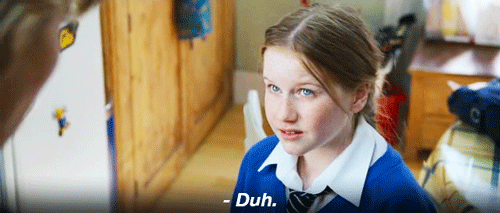
It had to be someone related to the League of Assassins and Talia would consider herself The Demon since Ra’s Al Ghul is dead. It’s not like Talia and Nyssa are besties. The amount of hoops Oliver had to jump through to get to The Demon also fits perfectly with Talia Al Ghul, as he notes.

The real question is how Talia ended up in Slabside and it seems we have Batwoman to thank. Nice shout out to Gotham and a not so subtle reference to the rapidly approaching crossover.

Talia survived Lian Yu, but it was Diaz’s super drug that healed her. Not unlike how it temporarily healed Diggle’s injury. Excellent tie in writers.

Talia is beholden to Diaz, but unfortunately she has no idea where he is. UGH.

It’s a little surprising Talia believes Oliver will help her escape. Listen girlfriend, you sided with Adrian Chase and his baby Mama ended up dead.

However, Talia (rightly) points out Oliver murdered her father. She’s not exactly an Oliver Queen fan. So, whatever Dr. Parker is doing to the prisoners is making Talia pretty desperate.
Oliver: You stood on the same side as Adrian Chase and my son lost his mother. So now I’m here trying to save what’s left of my family because I am stuck in a cycle of violence and I have been stuck there since the moment you told what to do with my father’s list.
(Not gonna lie, I was a little verklempt when Oliver referred to Samantha as his family. Olicity and Samantha would have killed it at co-parenting.)
It seems like Oliver has bought into Dr. Parker’s brain bullshit, but he’s just playing along. He doesn’t really believe he’s been stuck in a cycle of violence. I mean, he has but not in a bad way or at least not entirely. I also argue with his conclusion the cycle began when he met Talia. Oliver was thrown into violence the second he stepped onto the raft.

Talia didn’t create “the monster.” She just gave Oliver direction on how to use it.

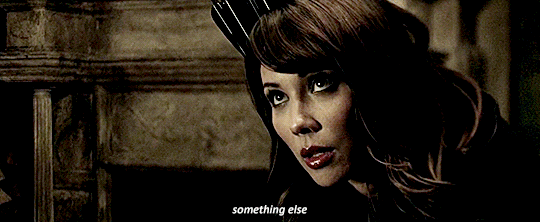

There are a couple reasons why Oliver is pretending to be brain washed. It is possible he believes he’s being watched and doesn’t want to tip off Dr. Parker. Also, he met “The Demon” and she can’t help him with jack, so I don’t think he’s highly motivated to blow his cover for Talia. Finally, Oliver isn’t convinced Dr. Parker is doing anything horrible yet. He’s not buying what Dr. Parker is selling, but Oliver still believes he is trying to reform prisoners. What’s wrong with that?
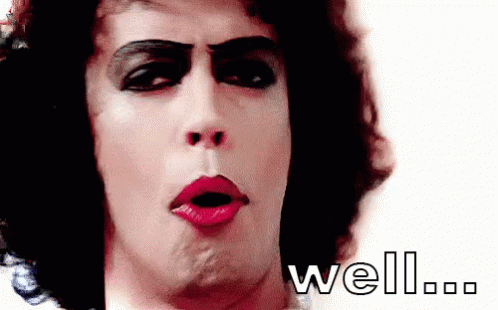
A lot if you try to kill them. When Oliver sees the dead body of the inmate who attempted to murder him in the shower fight, things start to look more alarming on Level 2. Talia is surprised Oliver cares about a man who tried to kill him, but he argues whatever is happening behind the creepy and nondescript door isn’t right. Talia is the one who told Oliver to help others and fight for justice, which is all he’s trying to do now.
This is an extremely important development for Oliver. Helping criminals has never been the Green Arrow’s modus operandi. Since Green Arrow is the warmer and fuzzier version of The Hood and The Arrow, you can trust neither of those identities were invested in helping criminals either. In fact, the Green Arrow put most of the criminals in Slabside. Oliver never thought much about why someone became a criminal and he never thought of them again after they were locked up. Of course, the locked up criminals are the lucky ones. There are many who never made it to jail. They went straight to a graveyard.

Oliver’s policy on killing is fluid, ever evolving and occasionally flip flopping, much to my frustration most of the time. Let’s review:
Season 1: Killing
Season 2: Not killing (except for The Count)
Season 3: Not killing (except for attempting to kill Ra’s Al Ghul on the mountain because Felicity said it was okay and ultimately killing Ra’s Al Ghul in the season finale)
Season 4: Not killing (except for Damien Darhk because he killed Laurel)
Season 5: Killing (except for Adrian Chase because that would’ve proved his point)
Season 6: Not killing (he never caught Diaz so the jury is still out on how Oliver plans to deal with him, but I am thinking jail)
Looking at this it’s fair to say Oliver doesn’t have a hard and fast rule when it comes to killing. He operated from a kill or be killed perspective in Season 1 and Season 5.
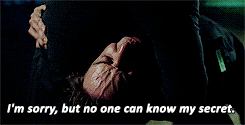
His “no killing” rule was set aside anytime the Big Bad was perceived as a large enough threat or for retribution in Season 3 and Season 4.

The whole point of having a moral code is to stick to it. If Oliver is prepared to deep six his code whenever it’s inconvenient or difficult to hold to then it’s not really a code. Hence, the reason I’ve been coming down on him so hard about this for the last seven years.

I believe all human life has value and therefore we cannot kill another human being. Of course, war or acting in self defense is a different story, but my overall stance on killing is a big, fat NO. However, I’m not losing any sleep over any of the people Oliver Queen has killed. These villains are awful, they did horrific things, and deserved to get got. We can even make the argument the world is a better place without these people in it.
However, simply because someone deserves to die doesn’t mean he/she should. Oliver doesn’t get to be judge, jury, and executioner simply because he wears a mask. He may catch criminals outside of the law, but Oliver is not above the law. His killing is a strong argument against vigilantism and Oliver has been striving to be a better hero for several years now.

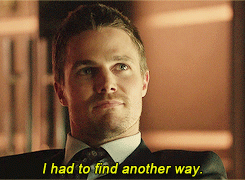

This isn’t entirely Oliver’s fault. For some reason, the writers are determined to box him into an either or choice. Either the criminal goes free or you kill him. I’ve been screaming, “WHAT ABOUT JAIL?” for the last seven years because guess what? We have a way of keeping society safe without killing the criminal.
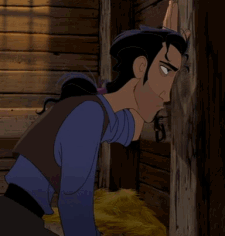
Is it a perfect system? Of course not, but no system is. Not allowing Oliver to avail himself of this option while Barry Allen gets to have his very own meta prison seems a little unfair.

Yes, men like Ra’s Al Ghul and even Damien Darhk may too much to handle even for Slabside, but Oliver had his very own A.R.G.U.S. prison on Lian Yu that he never used, except for Slade Wilson and the Boomerang guy.

Why? Because that’s Arrow and sometimes Arrow is dumb. They want to Oliver constantly deciding whether the villain lives or dies because it’s one way they mark his superhero evolution.
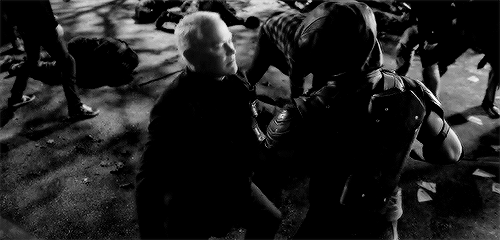
I was particularly hard on Oliver regarding Damien Darhk. Not because I believed Darhk deserves to live – he nuked an entire city. However, Oliver killed Darhk because he killed Laurel. Damien was unarmed and de-magicked. Oliver easily could have handed him over to the authorities. Instead, he drove an arrow through him on live television. Thus, creating many of the legal problems Oliver faced in Season 6 and Season 7.
And that’s the point. Killing doesn’t erase consequences. It creates them. Yes, maybe the villain escapes prison and more lives are lost. Maybe the justice system won’t work. Although are we really worried the legal system won’t punish perpetrators of mass genocide? No. Probably not.

Killing Ra’s Al Ghul ignited a rage in Talia. She sided with Adrian and played a role in Samantha’s death. If you want to know how Damien Darhk’s daughter turns out flip on Legends. It ain’t pretty.

Retribution begets retribution. This is the lesson Adrian Chase taught Oliver and so he began to view killing a different way in Season 6.
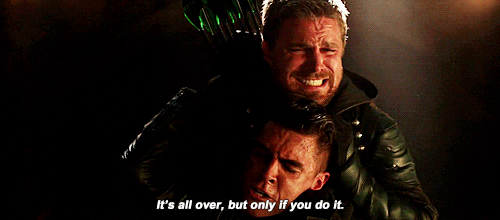

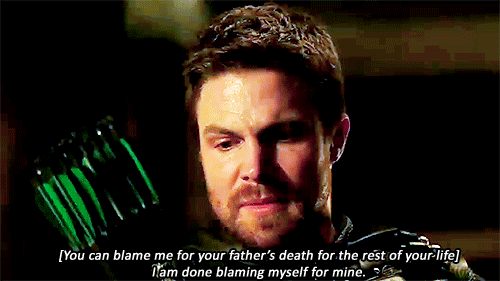
It’s why Oliver tried to catch Diaz and not kill him.
Oliver: These people are being treated like they are disposable. No one deserves that.
Oliver’s always evolving morality is taking a very important step. He is feeling empathy for the very murderers he helped locked away. Oliver believes these people deserve basic decency despite the horrible crimes they committed. He is beginning to see the criminals’ humanity.
Why is this important? Oliver’s “destiny” is to become the Green Arrow – a fully evolved superhero. Superheroes typically don’t kill. These characters, for the lack of a better word, are Christ like figures. Superheroes have integrity, determination, love, compassion, honesty and honor beyond the regular, everyday person. They are capable of things most people could never dream of doing. It’s why they inspire us. They challenge us to be better because they are better. It’s what makes them superheroes.
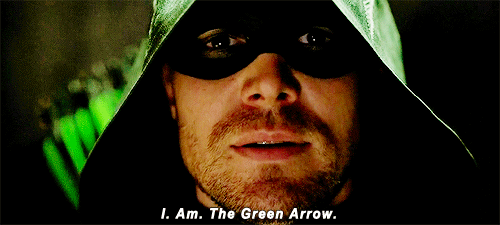
This is where Oliver is headed. His morality has to be beyond reproach. Superheroes don’t lie, cheat or kill. Oliver has worked very hard at fixing these problem areas in his life for the last ten years. Is he perfect? No, not even a superhero is perfect. He/She is pretty close though, which is hopefully where Oliver’s origin story ends.

Maybe you or I can’t feel empathy for a criminal, but Oliver Queen is called to be better than us. He will draw the line in the sand, so it’s important he doesn’t cross it. The Green Arrow will be the example Star City will look to, so his moral code better be unbreakable.
This means NO KILLING. Not even when the villain deserves it. Not even when Oliver has the moral high ground. Not even when Oliver deserves revenge. Not even when it may protect the city.
There will always be unforeseen consequences to killing, but the real reason Oliver shouldn’t kill is because every life has value. Oliver can understand and even empathize with some of these people now that he is considered a “criminal” too and has spent so much time with them. It will be very difficult for Oliver to kill a villain when he can see their humanity. It doesn’t mean they deserve freedom, but they don’t automatically deserve death either. There’s a middle ground here. If Arrow will finally allow the Green Arrow to avail himself of the prison system, then he can be a better example to the city.
Talia isn’t impressed with Oliver’s new found empathy for criminals, because he did not show it to her father when it mattered. Yeah, well your father tried to poison an entire city cutie, but that’s just details.
Oliver: No because I back then I still allowed the monster that you unleashed to take over.
This is how we know Oliver is faking with Dr. Parker. You can call it whatever you want – Oliver’s monster, darkness, demons, etc. The name doesn’t matter. Oliver has evolved beyond it. The rage he feels no longer controls him. He faced his “monster” in Season 5 and learned to control it in Season 6. He’s already dealt with all of these issues.
Oliver: Ra’s death was my fault. I couldn’t see past what he intended to do to my city, so I didn’t stop and think about his family, and for that, I am truly sorry.
I could argue Oliver deserves prison. Technically, he is a murderer and not all of his “kills” were done in self defense.

He acknowledges there was another way with Ra’s Al Ghul, but he didn’t take it. Talia is one of those unforeseen consequences to that decision and Oliver is truly sorry for the pain he caused her.
If you believe Oliver deserves redemption for some of those calls then apologizing to who he hurt is an important part of the process. It’s no different than Bl*ck S*ren. Is an apology enough? No, but Oliver has also spent six months locked away from his wife and child. He’s been beaten, tortured, psychologically lobotomized, and almost killed. (Also, I raise my “Ra’s Al Ghul committed mass genocide” flag again.) We’re not dealing with apples to apples here, but in the cosmic scale I think Oliver Queen comes out just fine.
Oliver and Talia fight their way into “the room” to take on Dr. Parker.

Source: @olivergifs
We get some extremely excellent fight scenes.I am so happy we are back to the days of Oliver taking down 50 bad guys by himself or with someone who actually knows how to fight.
Now it’s Oliver’s turn to drop some truths on Dr. Parker.
Oliver: My father pushed people away. He kept secrets, and I made those same mistakes. But if I choose to break the cycle, I’m gonna do it my way.

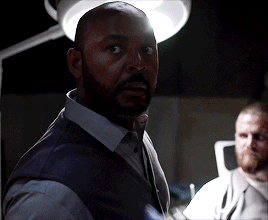

Source: olivergifs
MY SON IS SO GROWN!!!!!!

Oliver yelling his name in his growly voice will always be awesome. I am thrilled any time Oliver can achieve insights into himself and his father. It’s not the cycle of violence he needs to break. If he’s going to be the Green Arrow and Oliver Queen (and yes that’s where this is headed) then there’s going to be some violence. Oliver can tweak how much violence he’s going to engage in though.


What’s really important is breaking the cycle of lies and walls. Oliver cuts himself off from those he loves just like Robert Queen did. He has grown so much over the past seven years, and his sacrifice was so selfless, but he still lied to Felicity about prison. He made the decision without her. Every time Oliver lies and pushes people away he hurts those he loves and himself.
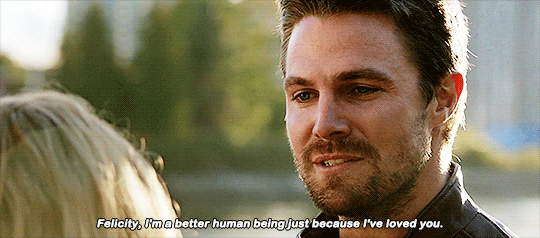

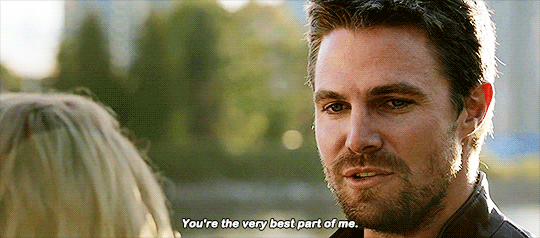
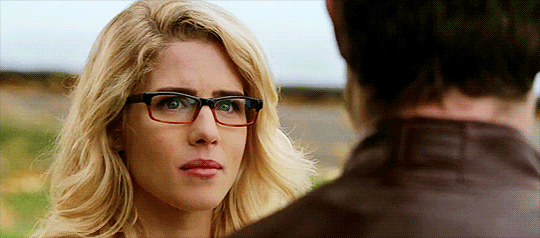
The monster no longer has power in Oliver’s life because he’s embraced love. Every time he chooses an unrighteous path it’s an opportunity for the monster to regain control. Every step away from the light is a step towards darkness. Being a good man is not limited to wearing a mask. He must be a good man as Oliver Queen and as the Green Arrow.
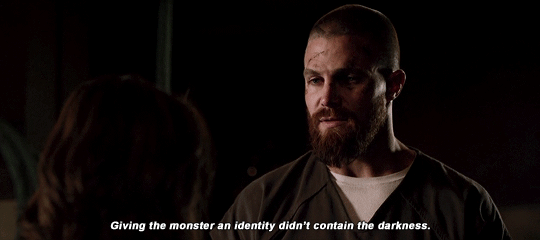

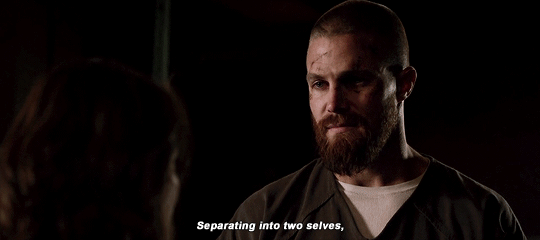
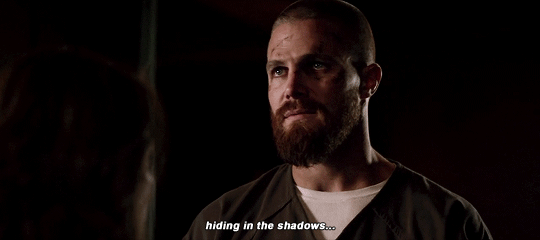

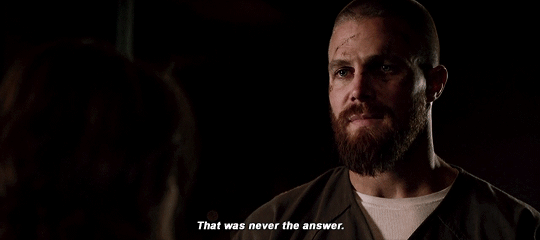
Source: @olivergifs
SEVEN YEARS Y’ALL!!!!!!!!!!! I HAVE WAITED FOR OLIVER QUEEN TO COME TO THIS CONCLUSION FOR SEVEN YEARS!!!!!!!!!

Season after season, review after review, waiting, watching and hoping for him to finally understand man and mask must be one. I am legit screaming. SCREAMING.

This was the light bulb I’ve been waiting to go off in his head. THIS MOMENT WAS EARNED! And worth the wait.

Oliver gives Talia the USB with the evidence they gathered to give to Felicity. He refuses to leave the prison because then he’d be a fugitive for the rest of his life. #OliverQueenPuttingHisFamilyFirstAlways.


Source: smoakmonster
Trust me, Talia. She knows.

Oliver returns to Level One and is reunited with his prison wife Stan, who quickly informs him his real wife came for a visit.

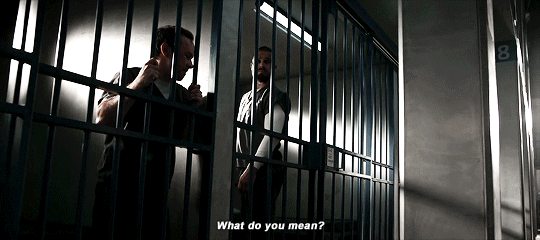
Every time Oliver hears Felicity’s name I swear to God his heart stops.
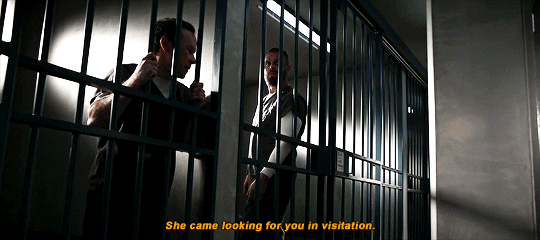

My heart broke for Oliver when he realizes he missed a precious visit with Felicity. He must have noticed she hasn’t visited as often as she could. (More on that in a minute).

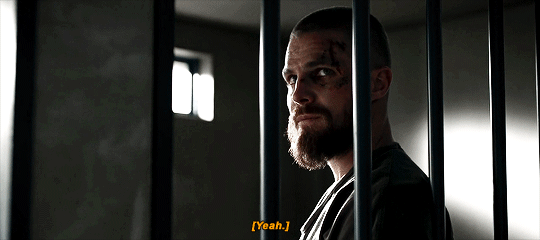
Source: oliverfelicitygifs
Stan tells Oliver that Felicity has a beat on Diaz and he’s not exactly thrilled. Oliver absolutely did not want Felicity going after Diaz and it’s clear he’s scared to death she’ll be hurt. He has no way of protecting or stopping her, which is exactly the point. Oliver doesn’t get to decide this time. He has to simply wait and see. Whatever is going to happen will happen. It’ll be interesting when these two are reunited because there are issues.
Oliver has retained his light inside of Slabside, he’s developed more empathy towards the people he’s fighting against, and he understands he can no longer separate his two identities. If Oliver is in need of redemption (particularly with Felicity) then I say he’s learned the necessary lessons to achieve it. It may be difficult for a time, but Oliver and Felicity will work through their problems once they are together again. In no small part because Oliver Queen is ready to be the man Felicity Smoak deserves and the hero Star City needs.

Source: smoakmonster
Felicity Smoak
I am falling in love with Felicity Smoak and Bl*ck S*ren. Nobody is more shocked than me. I don’t know what to tell ya.

They make the perfect odd couple. Felicity is sunshine and roses while Bl*ck S*ren is a snarky (reformed?) murderer. There are some similarities to Oliver and Felicity or Laurel and Tommy, which is probably one of the reasons I am enjoying it so much. Light meets dark. Funny meets serious.
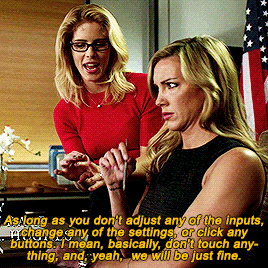

Source: hollandrooden
The sass and banter is funny and honest. Neither is worried about hurting the other’s feelings because they aren’t really friends. It allows the characters to say things to each other Felicity and our L*urel would never say. It also makes the development of whatever potential friendship they may have in the future feel natural.

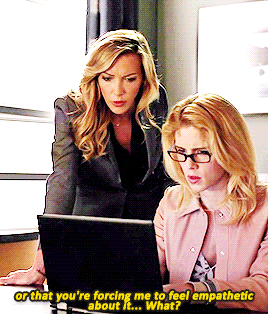
Source: dinah-lance
Whereas with L*urel, I feel her friendship with Felicity was rushed and didn’t develop organically. We went from L*urel glowering and not speaking to Felicity to immediately “favor friends” inside of a single episode.
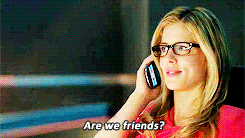

HUH?

It was also a little weird how they never talked about the Oliver shaped elephant in the room too, but whatever that’s all past. None of this is a problem with Bl*ck S*ren and F*licity. In fact, all the things I asked for with L*urel L*nce I am actually getting with Bl*ck S*ren.
The writers are giving Bl*ck S*ren screen time to develop at a semi reasonable pace, the lawyer thing notwithstanding.
The other characters aren’t pretending she’s a saint or glazing over her mistakes. Bl*ck S*ren is being held responsible for the things she’s done wrong.
Felicity (and Oliver) have no problem taking shots at Bl*ck S*ren occasionally, because they don’t trust her and she deserves them.
Bl*ck S*ren fires back (hilariously I might add) and is rapidly becoming the Spike to Team Arrow’s Scooby Gang - something I think the show needs.
Bl*ck S*ren is lawyering more than Laurel ever lawyered even though she’s not a laywer, which is hilariously amazing in an off kilter sort of way.
Most importantly, she’s helping Felicity in a way that’s actually helpful!
If Bl*ck S*ren helps get Oliver out of prison and then my faves have all the sex, Imma gonna bake her cake or something. Anyone assisting Felicity this season gets an A+ and a gold star from me and Bl*ck S*ren is at the top of that list.

Listen, nobody is as shocked as me since I was loudly advocating for BS to remain evil. I still like her evil and will be fine if she regresses. However, if they are going to have a L*urel type character on this show then I want the writers to use her effectively. Thus far, they are with Bl*ck S*ren. It may all go to hell in a hand basket shortly, but for now leave me to my joy.
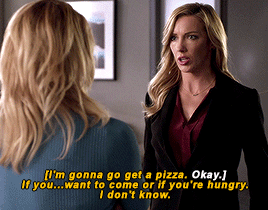

Source: felicitysmoakgifs
The best scene was BS asking Felicity out on a friend date. It was almost as cute as Oliver asking Felicity out. It was really sweet to see the part of BS that craves human connection reaching out to Felicity in such an adorably awkward way.

Alright, that’s enough about Bl*ck S*ren. Time to talk about our girl. Did anyone notice Felicity seems reluctant to visit Oliver?

Source: smoakmonster
Bl*ck S*ren tells Felicity to visit her husband and essentially kicks her out of the office. Welcome the Olicity ship BS! The bar is in the back.

Her reluctance is very telling. Felicity is feeling bad about her last visit with Oliver. Girl, why? You’re fine. The man has lessons to learn.

Unfortunately, Felicity is denied access to Oliver when she arrives. Felicity demands to see Oliver and think she uses “wife” and “husband” about twenty times in a sentence. Remember when we held our breath for one “wife” or “husband” last season? Now they use it with reckless abandon. It’s fabulous.

I have been dying for Felicity to meet Stan and yet I had no idea how Arrow would logically put these two characters together. I know logic isn’t always Arrow’s thing, but it’s not like Felicity can run into Stan and Oliver having dinner together. Turns out, this is not that hard!



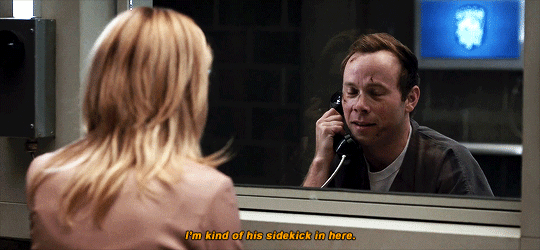
Stan lets Felicity know Oliver has been moved to Level 2. I will always be eternally grateful to Stan for telling Felicity the photograph has become Oliver’s binky.

I guess I was a little surprised at Felicity’s shock over Oliver stabbing a guard. She’s very “He would never!” about it whereas I am more “Sounds right. He broke a dude’s neck once.” Yes, that was during Oliver’s pre-Felicity days, but he’d burn down Slabside if it means protecting her and William. Her whole “Oliver is a choir boy” reaction rang false to me because Oliver is not a choir boy.
The first person Felicity runs to for help is BL*CK S*REN. We are living in the Upside Down.

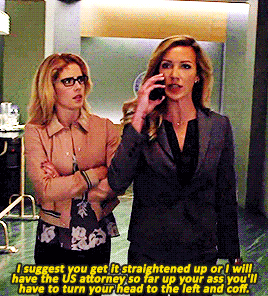
Source: dinah-lance
How much did you love Bl*ck S*ren yelling and threatening so Oliver and Felicity can visit each other? C’mere girl. Sit next to me. I made you a margarita.

Felicity confirms she’s only been there ONCE, and granted she was in witness protection for most of Oliver’s incarceration, but yeesh. It has to sting a little for Oliver that she hasn’t been back since. Don’t lie and make unilateral decisions next time, big fella.

Felicity would visit in sexy lingerie and bring store bought baked goods if you just LOOP HER IN.
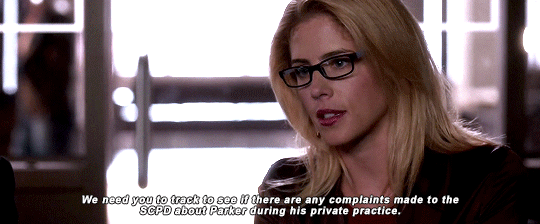
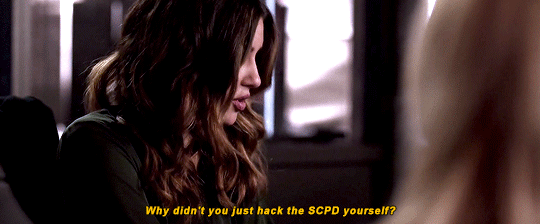



Source: felicitysmoakgifs
Bl*ck S*ren and Felicity go to Dinah to get information on Slabside’s Level 2, since there are no digital records.



Source: oliverfelicitygifs
Dinah hems and haws about helping Felicity, and she pretty much has to beg, which ticks me off to no end. You are part of the reason Oliver is in prison, Dinah. MOVE YOUR ASS. If Felicity wants to access to the evidence room you should be making her a copy of the key so she can come and go as she pleases. #NewbiesStopPissingMeOff2018

The records are a mess.

Source: dinah-lance
Dinah and BS spend a lot of time arguing about which legal method is best to help Felicity, but to be frank both their ideas suck and take too much time. Felicity kind of loses it.

Source: oliverxfelicity
She’s feeling an immense amount of guilt for being angry with Oliver over his decision to go to prison and not visiting. In typical Felicity fashion, she blames herself for whatever Oliver is going through. She believes she could have prevented it.

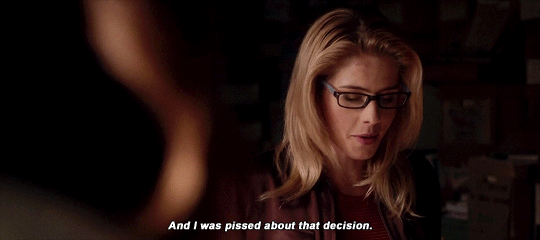


Source: oliverfelicitygifs
Felicity Smoak breaks my heart. Listen sweetie, Oliver is a big, dumb oak tree A LOT. It’s okay to get mad at him sometimes. This man is a full time project. He’s exhausting.

If anyone is concerned about Felicity and Oliver’s marriage then this speech should tell you everything you need to know. Being mad at your partner does not automatically mean you don’t want to be with your partner. Marriage doesn’t work like that. For better or for worse is legit. You can be so angry with your spouse you want to throttle them and yet still love them more than anything else on this earth.
Felicity can be mad at Oliver and still be madly in love with him. What Oliver did is no little thing. He made a massive and unilateral decision for their entire family without consulting Felicity. She has to live with the consequences, but had no say in her own life.
We’ve seen time and again when Felicity is angry with Oliver she needs time and space to process those emotions. Felicity needs to work through her feelings before she can work through the problem with Oliver. It doesn’t mean she wants to end their relationship.
While she’s been looking for Diaz and processing her anger, Oliver has been going to extremes in his battle to track Diaz too. Unfortunately, now he’s missing.

This all hits Felicity where it hurts because her worst fear is losing Oliver. She thought losing her husband was bad enough, but now Felicity is scared Dr. Power’s mind warp program will take Oliver from her forever.
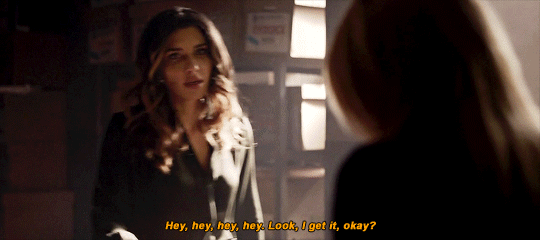

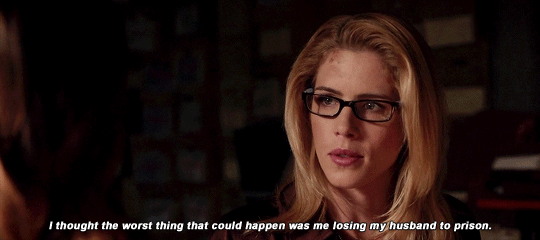
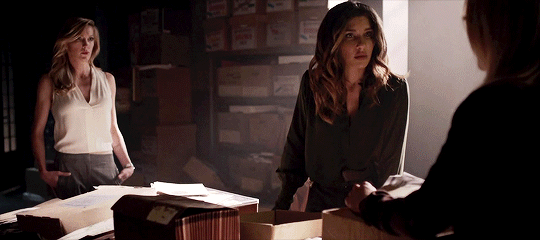

Source: oliverfelicitygifs
I just want to hug Felicity and tell her she doesn’t have to worry about Oliver’s mind being erased.

He dealt with all his deep and dark issues in the sewer with her. Felicity loved him through it and that’s the reason Oliver has remained intact on this new island. UGH. MY BABES.
Oliver and Felicity have remained connected despite their physical separation, but the distance is having an impact on them. They are starting to feel the consequences of time, distance, hurt feelings, and lack of communication. ENOUGH ALREADY! LET THEM BE TOGETHER! I WANT IT TO STOOOOOP!

Long story short, Felicity discovers Dr. Powers is going to erase Oliver’s mind and finds evidence connecting him to a cold case murder. That, along with Oliver’s evidence, is enough to get the Level 2 program shut down. It makes me a little sad Felicity doesn’t know the evidence is from Oliver. TALIA YOU HAD ONE JOB.

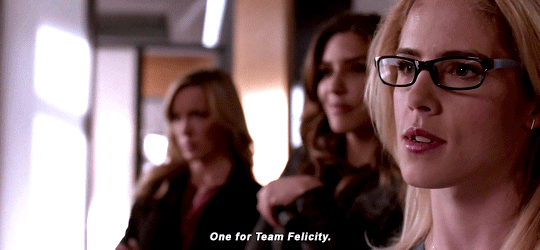
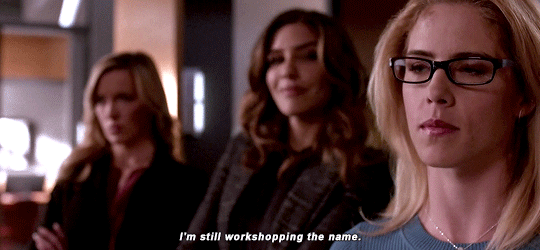
Source: felicitysmoakgifs
Team Felicity, yes that’s the name, has such a fantastic light bulb moment when they realize they can use this Slabside evidence to appeal Oliver’s conviction. I don’t know how. I’m not a lawyer. I don’t know how Oliver was convicted in the first place because he was acquitted. How is he legally in prison? Whatever. I don’t care. Just get him out and send him home to his woman. That’s all I want. I’ve enjoyed the prison arc more than I anticipated, but I’m ready to be done.
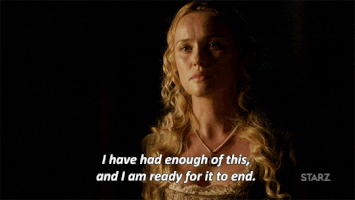
Curtis and Diggle
Lord people. I cannot with Curtis. His undercover mission takes up a significant chunk of the episode and this is how much I care:

Fourteen PhDs???? FOURTEEN!!!!!!!??????

I am trying to hang with you show, and I realize you are a fantasy drama, but this is not humanely possible. Also, I am taking issue with Diggle reading out Curtis’ credentials when just last week Felicity tipped her hat to her credentials. She mentions going to MIT and then next week we are listing Curtis’ ridiculous number of PhDs and six languages?!

It feels like a bizarre pissing contest and yet these writers want me to believe this character is not in competition with Felicity.

Cammien Ray tweeted something brilliant yesterday and I thought it really summed up one of my primarily beefs with Curtis and Diggle having this storyline. This is everything we asked for Felicity, but they gave it to Curtis.

Felicity is off doing her own hero-ing and therefore the writing team’s ass is saved, but this character is in constant competition with Felicity. More often than not, Curtis over shadows Felicity so he has a friggin purpose on this show. Arrow is an extremely male dominated series. We don’t need one of few strong female characters sidelined for another male character’s benefit.

Curtis bemoans all of the misery being a vigilante has brought into his life. Yes, Curtis has suffered the most out of all the characters.

Oliver lost his freedom, Felicity lost her husband and child and Dinah’s boyfriend is dead. Hell, even Rene has more to bitch about. Zoe’s life was in danger for most of Season 6. BL*CK S*REN has more to be upset about. Her boyfriend, father and pseudo father figure are all dead.
But Curtis? He got a divorce. Sure, that’s sad, but his ex husband isn’t dead. Curtis is probably paying him alimony.

Curtis was stabbed, his boyfriend shot, THEY BOTH SURVIVED, but woe is me.

Diggle has the audacity to compare Curtis to soldiers who have fought in war.

We are not comparing Curtis and his T balls to men serving in the military. The reason why Curtis doesn’t look “done” when compared to those soldiers, John is because HE HAS NOT FOUGHT IN A FUCKING WAR OR SUFFERED ANYWHERE NEAR THE AMOUNT THOSE HEROES HAVE.
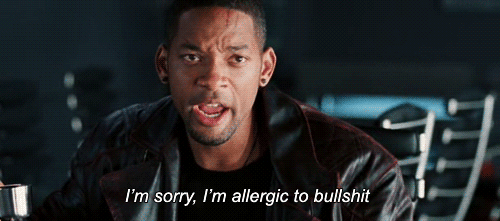
Both of you please shut up.
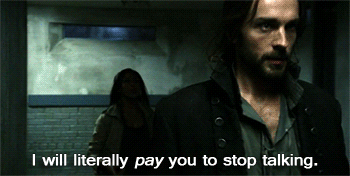
I couldn’t understand why Diggle was arguing for Curtis to remain Mr. Terrific when he’s given up on Spartan and Green Arrow. This is the second character IN A ROW Diggle has argued to break the rules and continue life as a vigilante. Whereas when it comes to Felicity she can’t be Overwatch or break any laws to free her husband.

I also don’t understand why Diggle is arguing Curtis is so vital to the team when the truth is there are other characters that can do what he does and BETTER. Rene and Dinah are better fighters than him. This is the first week he looked mildly proficient in the field. This is why I say he’s the new LL. One week he can’t take down one bad guy, but the next he’s fighting twenty different people. It’s inconsistent and illogical.
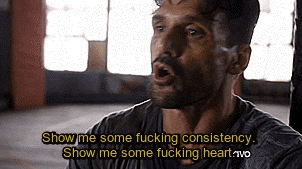
Felicity is a genius and all the tech goddess we need.

Anytime they use Curtis’ brilliant mind it’s to short change her. NO THANKS. The only thing Curtis brings to the table is his T spheres and pretty much everyone can operate them. I am quite annoyed with Diggle for trying to talk Curtis out of sidelining himself.

Arrow continues to glaze over Curtis’ role in Oliver ending up in prison, there’s been no apology and he refuses to help Felicity. Instead, they write an episode where Curtis is given all the storylines we’ve asked for Felicity. Then Curtis whines about how tough life is when the other characters he refuses to help are suffering more. This is not the way to win me over. USE THIS CHARACTER LESS. He needs to disappear from my TV screen for a long time or, God willing, permanently. The more this show shoves this character down my throat the more I dislike him and I have a sensitive gag reflex.
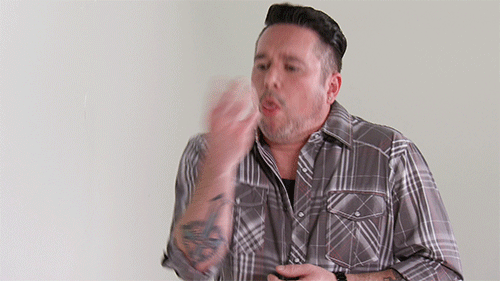
Stray Thoughts
“Empathy’s a word I’m learning. It’s a work in progress” HA! Loved this line.
I know neither Dinah nor BS are Felicity’s besties, but it was nice having all the women work together in an episode. It also gave Felicity a chance to unload some of her grief and fears. Can we make this a regular thing? Felicity needs girlfriends.
“I taught you to separate the man from the monster. Instead, you exposed your true identity for all the world to see and became the monster you always feared you were.” Bitch where?
Talia teaching Oliver to separate his two selves ultimately lead to her father’s death, so there are consequences for her choices too.
Felicity changes out of her high heels and skirt into jeans and tennis shoes for her visit with Oliver. The practicality in Felicity’s wardrobe this year is A+, so let’s keep the logic. Nobody drives to a prison in heels and she sure as hell shouldn’t wear them out in the field.

Oliver’s face when he finds out there’s no visitation in Level 2 looks like he was just told his puppy has cancer. Source: olivergifs

You have not met Felicity “I Will Always Always Always Wait For You” Smoak. Suck a hot one, guard. Source: olivergifs
Why are the A.R.G.U.S. uniforms so dorky? Let’s cool them up costume department.
I need Stan to be good. Can we just let Stan be good?
Stephen Amell is 6 ft so the inmate who died is ENORMOUS.
Don’t you love how there’s been zero Diaz in any of these past few episodes? He’s just like the Boogey Man, but we never have to see him. It’s fantastic.
I don’t buy for a second Diaz took out a bunch of Bratva, but my larger concern is don’t hurt my Anatoly.
No flashbacks. Interesting.
That Elseworld promo was jarring. I’m scarred for life.
Disclaimer: Any gifs on the blog are not mine. If you would like a gif removed from my reviews, please message me. 7x05 gifs credited.
If you’d like to support the blog, please buy me a cup of tea!
#arrow#arrow 7x05#oliver queen#felicity smoak#olicity#arrow season 7 reviews#anti black siren#anti john diggle#anti laurel lance#anti dinah drake#arrow season 7 episode reviews#season 7 episode review
115 notes
·
View notes
Text
Why a Banking Heiress Spent Her Fortune on Keeping Immigrants Out https://nyti.ms/2Mf71Od
"The main groups cultivated new allies in Congress, none stronger than Jeff Sessions, then a senator from Alabama, whose office served as an unofficial Capitol Hill headquarters for the restrictionist movement. Mr. Sessions, who later became attorney general in the Trump administration, hired as a spokesman Stephen Miller, who would give a keynote address at a Center for Immigration Studies event years later, in 2015, before joining the Trump campaign."
This is exordinanry look at a banking heiress who spent her fortune on keeping immigrants out of the United States. The 'New Nativist' Articles in this series examine the evolution of hard-line immigration politics.
Why a Banking Heiress Spent Her Fortune on Keeping Immigrants Out
Newly unearthed documents reveal how an environmental-minded socialite became an ardent nativist whose money helped sow the seeds of the Trump anti-immigration agenda.
By Nicholas Kulish and Mike McIntire | Published August 14, 2019 | New York Times | Posted August 14, 2019 8:02 PM ET |
She was an heiress without a cause — an indifferent student, an unhappy young bride, a miscast socialite. Her most enduring passion was for birds.
But Cordelia Scaife May eventually found her life’s purpose: curbing what she perceived as the lethal threat of overpopulation by trying to shut America’s doors to immigrants.
She believed that the United States was “being invaded on all fronts” by foreigners, who “breed like hamsters” and exhaust natural resources. She thought that the border with Mexico should be sealed and that abortions on demand would contain the swelling masses in developing countries.
An heiress to the Mellon banking and industrial fortune with a half-billion dollars at her disposal, Mrs. May helped create what would become the modern anti-immigration movement. She bankrolled the founding and operation of the nation’s three largest restrictionist groups — the Federation for American Immigration Reform, NumbersUSA and the Center for Immigration Studies — as well as dozens of smaller ones, including some that have promulgated white nationalist views.
Today, 14 years after Mrs. May’s death, her money remains the lifeblood of the movement, through her Colcom Foundation. It has poured $180 million into a network of groups that spent decades agitating for policies now pursued by President Trump: militarizing the border, capping legal immigration, prioritizing skills over family ties for entry and reducing access to public benefits for migrants, as in the new rule issued just this week by the administration.
How $180 Million of May's Fortune Has Fueled the Anti-Immigration Movement
From 2005 to 2017, the Colcom Foundation gave millions to anti-immigration and population-control groups, some with close ties to the Trump administration.
Mrs. May’s story helps explain the ascendance of once-fringe views in the debate over immigration in America, including exaggerated claims of criminality, disease or dependency on public benefits among migrants. Though their methods radically diverged, Mrs. May and the killer in the recent mass shooting in El Paso applied the same language, both warning of an immigrant “invasion,” an idea also promoted by Mr. Trump.
In many ways, the Trump presidency is the culmination of Mrs. May’s vision for strictly limiting immigration. Groups that she funded shared policy proposals with Mr. Trump’s campaign, sent key staff members to join his administration and have close ties to Stephen Miller, the architect of his immigration agenda to upend practices adopted by his Democratic and Republican predecessors.
“She would have fit in very fine in the current White House,” said George Zeidenstein, whose mainstream population-control group Mrs. May supported before she shifted to anti-immigration advocacy. “She would have found a sympathetic ear with the present occupant.”
Unlike her more famous brother, the right-wing philanthropist and publisher Richard Mellon Scaife, Mrs. May largely stayed out of the public eye. A childless widow who lived alone outside Pittsburgh, she instructed associates not to reveal her philanthropic interests and in some cases even to destroy her correspondence. While her unlikely role as the quiet bursar to anti-immigration organizations has been previously reported, her motivation and engagement in the immigration issue remained largely hidden.
The New York Times, through dozens of interviews and searches of court records, government filings and archives across the country, has unearthed the most complete record of her thinking. Mrs. May’s unpublished writings reveal her evolution from an environmental-minded Theodore Roosevelt Republican — in 1972 she was the nation’s largest single donor to mainstream congressional candidates — to an ardent nativist. Her ideological transformation presaged the Republican Party’s own shift from blue-blooded, traditional conservatism toward hard-right populism.
Chatty, handwritten notes to John D. Rockefeller III, the philanthropist Helen Clay Frick and the head of the National Audubon Society about luncheons and overseas trips gradually gave way over the years to darker exchanges with fringe figures who believed that black people were less intelligent than white people, Latino immigrants were criminals and white Americans were being displaced.
But Mrs. May disputed the notion that she was racist, writing to a grant recipient in November 1994, “Can we not put imaginary paper bags over the immigrants’ heads, see them as colorless consumers, and count only their deleterious numbers?”
Restrictionist groups she financed have blocked attempts at amnesties and immigration reform bills in Congress over the years. They fought for Proposition 187 in California to deny education, routine health care and other public services to undocumented immigrants; they argued against in-state tuition for the children of undocumented workers in Utah. They supported “show me your papers” laws in Arizona and Georgia and draconian local ordinances in Hazleton, Pa., and Farmers Branch, Tex.
“We occupied the space before anybody, and the people who helped found the organization and fund the organization, including Mrs. May, were people of enormous foresight and wisdom,” said Dan Stein, president of the Federation for American Immigration Reform, who knew Mrs. May. “They would be gratified over the fact that we’ve seen these ideas championed at the highest level.”
The groups have wasted little time seizing the moment since Donald Trump came to the White House. As Mr. Stein’s organization, known as FAIR, put it in a federal tax filing last year, Mr. Trump’s election presented “a unique opportunity” to enact its longstanding agenda of “building the wall, ending chain migration, rolling back dangerous sanctuary policies, eliminating the visa lottery” and more.
Nowhere in the document is the name of its largest benefactor ever mentioned.
“Without Cordy May, there’s no FAIR,” said Roger Conner, the organization’s first executive director. “There was no money without her.”
Two Passions Converge
Mrs. May’s immigration activism began in the 1970s, when the numbers of legal and illegal arrivals in the country were reaching heights unseen in decades. But she grew up during a period with the lowest levels of immigration in a century (and lower than any period since), thanks to a 1924 law that imposed strict quotas favoring Western European migrants. Her family lived in a part of the picturesque Ligonier Valley, outside Pittsburgh, that was more than 99 percent white when she was a child.
When the first photographs of an infant Cordelia Mellon Scaife appeared in newspapers across the country, she was heralded as potentially “the richest baby in the world.” Her life would be one of privilege: Her family vacationed in St. Moritz, Switzerland, and in Palm Beach, Fla., their movements tracked in society columns.
Young Cordy grew up in a stately Cotswold-style manor, staffed with servants, known as Penguin Court. Her eccentric mother, Sarah Mellon Scaife, tried to breed emperor penguins to waddle the grounds after the craze over Adm. Richard E. Byrd’s Antarctic expeditions.
But Mrs. Scaife, a sharp-tongued art collector, was an alcoholic and her daughter later described her youth as largely miserable. A friend of her parents, the dancer-actor Fred Astaire, tried to help her get discovered in Hollywood when she was 19 but her trip was ill timed. “The only star around was Lassie,” she remarked to an author, Burton Hersh, writing about the Mellon family.
After a marriage at age 20 that lasted just a few months, Mrs. May joined in the family tradition of philanthropy. Her mother had provided funding for Dr. Jonas Salk’s lab at the University of Pittsburgh, where he developed the polio vaccine. Mrs. May became active in local charities, including a children’s health center and a school for the blind, and started the Laurel Foundation in 1951, when she was 23, to channel her giving. She also donated to Republican candidates, both local and national.
But it was Margaret Sanger, the famous and, in some circles, scandalous founder of Planned Parenthood, who provided the sense of direction Mrs. May had craved. Mrs. Sanger was a close friend of her grandmother. Mrs. May acknowledged that it was not the birth control pioneer’s “works or ideals” that initially appealed to her but the fact that she had been jailed for her activities.
Mrs. May first worked for the Planned Parenthood chapter in Pittsburgh and later joined the board of the International Planned Parenthood Federation. “I have always admired and tried to take a part in the work that you started,” she wrote in a 1961 letter to Mrs. Sanger.
Mrs. May appeared to live relatively modestly, considering her means, but she kept a private jet nearby and flew around the world on nature expeditions. She was more comfortable banding birds at a wildlife sanctuary than hobnobbing at a cocktail party. She lived in the woods in Ligonier in a house she called Cold Comfort, after the satirical British novel “Cold Comfort Farm.” (The book’s heroine meddles in the lives of her distant rural relations and even counsels a servant about birth control.)
Her twin passions, protecting natural habitats and helping women prevent unplanned pregnancies, merged over time into a single goal of preserving the environment by discouraging offspring altogether. “The unwanted child is not the problem,” she would later write, “but, rather, the wanted one that society, for diverse cultural reasons, demands.”
Colcom Foundation giving to anti-immigration and population-control groups dwarfed its giving to environmental and other causes.
Western Pennsylvania Conservancy
$13.7 million
Immigration & population control
$179.9 million
Environment
$76.3 million
Other
$55.4 million
Source: Colcom Foundation tax filings for fiscal years 2005-17. | By Weiyi Cai
For some of America’s elite in the 1960s and ’70s, supporting efforts to limit population growth was partly an act of noblesse oblige. The Fords donated millions for United Nations-backed family planning projects worldwide.
Mrs. May joined the board of the Population Council, a group founded by John D. Rockefeller III that emphasized family planning and economic development as ways to lower birthrates around the world. She and some relatives together contributed $11.4 million to the council during the 1960s, and Mrs. May joined the group’s president, Frank Notestein, on trips to Asia to review projects.
Overpopulation became an even more mainstream concern in the United States after the runaway success of “The Population Bomb,” the 1968 book by the Stanford biologist Paul Ehrlich. After the enormous bulge of baby boomers, many Americans came to favor smaller families.
But a 1973 letter to the Population Council from Mrs. May’s office revealed her increasingly tough stance on population control. Contraceptives had made too little impact, the letter said.
“Although we are conscious of the highly sensitive nature of this subject,” it said, “we feel confident that the leadership position of the council in the population field can be used to greatly accelerate the availability of abortion services worldwide on an ‘abortion upon request’ basis.”
Sealed Borders and Sterilization
In August 1973, Mrs. May secretly remarried, this time to her childhood friend and longtime companion Robert W. Duggan, the district attorney in the county that includes Pittsburgh. The couple paid $5 for a justice of the peace in Nevada to wed them in a remote spot on Lake Tahoe.
When the marriage was disclosed, it made front-page news in Pittsburgh, in part because her new husband was fighting to stay out of prison amid a federal corruption probe. The swift nuptials had come between his appearances before a grand jury, and just days after Mrs. May was summoned by the Internal Revenue Service.
Six months later, Mr. Duggan was indicted for evading taxes on payoffs he received from an illegal gambling ring. The same day, he was found dead at his country house, apparently from a self-inflicted gunshot.
Mrs. May blamed her brother for turning on her husband. The siblings had long shared advisers, worked on charitable matters together and helped each other, but the rupture was so complete that they stopped speaking. The scandal and the ensuing tragedy in essence robbed Mrs. May of her two closest confidants.
In a letter to her fellow Pittsburgh-born heiress Helen Clay Frick, Mrs. May described how she had “wangled a cabin from a ranger in a remote canyon in Arizona,” where, she said, she had responded to nearly 2,500 condolence cards. She turned her attention to population meetings at an upcoming United Nations conference, which, she wryly concluded, would feature demands for wealth redistribution and “a thorough denunciation of the United States.”
By the end of the year, after more than two decades working with Planned Parenthood, she had resigned from the group. Two years later, her top aide delivered a stern message to Mr. Zeidenstein, the new president of the Population Council: Family planning and famine relief were a waste of money. Instead, “the U.S. should seal its border” with Mexico. According to a memo by Mr. Zeidenstein, Mrs. May’s views were becoming so radicalized that “one got the impression” she favored compulsory sterilization to limit birthrates in developing countries.
Mr. Rockefeller, taken aback by Mrs. May’s shift, wrote to her that he “had not been aware that differences of this seeming magnitude existed between us.” She responded that she would have severed ties sooner if not for her regard for him, and sent him the mission statement for a new group she had bankrolled, the Environmental Fund.
Buried in the document was a telling reference. “Immigration,” the statement said, “should also be brought into balance with emigration immediately.”
Courting Mrs. May
The Environmental Fund pushed mainstream concerns about overpopulation to the fringe and stoked opposition to immigration. Virginia Abernethy, a self-described “ethnic separatist” who became involved in the group, now called Population-Environment Balance, said in an interview that Mrs. May was “the first person who comes to mind” of those who pushed the population-control movement to oppose immigration.
“She funded a great deal of the original research,” said Ms. Abernethy, a retired Vanderbilt University professor who spoke last year at a white nationalist conference headlined by the former Ku Klux Klan leader David Duke.
Through her work with the fund, the heiress struck up a close friendship with Garrett Hardin, a microbiologist and ecologist who argued that the modern welfare state encouraged overpopulation and ecological depletion. When Mrs. May sent him news clippings about riots in Los Angeles, Mr. Hardin responded that the media was finally seeing that “maybe the blacks are less than saintly” and lamented “the predominant Latinity of apprehended criminals” where he lived in California.
“The hope of the future,” he said, “lies in the intelligent practice of discrimination.”
She also met John Tanton, a charismatic eye doctor and environmentalist from Michigan, who would leverage Mrs. May’s financial resources to propel the budding anti-immigration movement forward.
With the square-jawed good looks of a soap opera M.D., Dr. Tanton, who died last month at 85, worked with Planned Parenthood and the Sierra Club and was the national president of Zero Population Growth in the 1970s. As the Baby Boom ebbed, he turned his attention to curbing immigration.
In 1978, immigration surged: The Border Patrol apprehended 863,000 unauthorized immigrants, the most in over two decades. Another 601,000 legal immigrants also arrived, the greatest number since the 1924 immigration act. U.S. News & World Report published a cover story the next year sounding the alarm about chaos at the border with “illegal aliens.”
That November, Dr. Tanton wrote a nine-page proposal for funding from Mrs. May to start a group called the Federation for American Immigration Reform, or FAIR.
“We plan to make the restriction of immigration a legitimate position for thinking people,” he wrote. Mrs. May provided $50,000 to get the group off the ground.
FAIR’s early policy goals, some reflected decades later in proposals pursued by the Trump administration, called for not only an end to illegal immigration, but also a sharp reduction in legal migration. The group advocated increased funding and staffing for Border Patrol to police the southern frontier, campaigned against Cuban refugees and pushed to restrict public benefits for undocumented immigrants.
Dr. Tanton redoubled his attention to Mrs. May with flowery letters quoting Shakespeare, research into birds she was curious about and recommendations for a game ranch in Kenya. He invited her to a nature preserve in Michigan.
His internal memorandums betrayed the cold calculus behind his attentions. “Mrs. May has been our single biggest supporter. She just gave us another $400,000,” he wrote. “That relationship is pretty well under control.”
Patrick Burns, an early employee of FAIR who would often talk to Mrs. May at the group’s events, saw her as vulnerable. “She was isolated up in Ligonier and John was a predator who got inside her perimeter wire and basically found a source of money to fund the immigration reform movement,” he said in an interview. “John looked at Cordy as a buffalo to hunt and bone out for wealth.”
The Tanton-May Network
Mrs. May faced criticism even from within her family for the groups she supported. A young cousin asked whether her causes weren’t discriminatory, racist or, as Mrs. May recalled in a letter, “the one that really puts my teeth on edge … ‘elitist.’”
She produced a five-page typed response, rife with comments about Filipinos “pouring” into Hawaii and “Orientals and Indians” sneaking across “long stretches of unmanned border” with Canada.
She compared medical science’s success in reducing infant mortality rates to veterinarians prolonging the lives “of useless cattle.” Birthrates had dropped in a few areas, she noted, and millions died of starvation every year, but population growth rates continued to climb. “Even wars no longer make much dent; during 11 years of conflict, both North and South Vietnam showed a net increase in population,” she wrote.
Legal and illegal immigration led to overpopulation, she said, “the root cause of unemployment, inflation, urban sprawl, highway (and skyway) congestion, shortages of all sorts (not the least of which is energy), vanishing farmland, environmental deterioration and civil unrest.”
Mrs. May’s Laurel Foundation gave $5,000 to the Institute for Western Values to distribute a translation of the French dystopian novel “The Camp of the Saints” in the United States. The book, about an invasion of poor immigrants overwhelming Europe, is an essential text in white-nationalist circles and has often been cited by the former Trump adviser Steve Bannon. A subsequent English edition was published by the Social Contract Press, which was founded by Dr. Tanton and funded by Mrs. May’s foundation.
Mrs. May credited Dr. Tanton with helping her realize she could take a stand for her beliefs. “I used to think that you just had to take it,” she said during a 1985 visit to the offices of U.S. English, his initiative to make English the official language of the United States. “You don’t: You can organize and be active and do something about it.”
Internal FAIR documents show that her advisers played just such an active role in the development of Dr. Tanton’s growing network of groups. Mrs. May’s longtime adviser Gregory Curtis advocated splitting off FAIR’s research component, which became the Center for Immigration Studies in 1986. Dr. Tanton also broke off FAIR’s litigation arm, and continued founding or fostering new groups.
The move was “critical in not just hiding the sources of funding, but it allowed his creations to meet the I.R.S.’s so-called public support test,” which prevents charities from relying too heavily on a single donor, said Charles Kamasaki, a fellow at the Migration Policy Institute who has worked on the pro-immigration side of the issue. “Part of Tanton’s genius, and it really was genius, was creating these multiple shells,” he said.
The sheer number of groups nurtured with Mrs. May’s money — dozens over four decades — played an important role in the success of the anti-immigration movement by giving it the appearance of broad-based support. Groups would send representatives to appear before Congress, talk to journalists and provide briefs in lawsuits, without disclosing their common origins and funding.
When Dr. Tanton had trouble getting grass-roots support for an Arizona ballot initiative in 1988 to require government business to be conducted only in English, he turned to Mrs. May to pay canvassers. When he decided in the 1980s to host a gathering of a brain trust to strengthen the intellectual underpinnings of the movement, Mrs. May committed $15,000 a year and the use of her Gulfstream jet.
Among those who attended over the years were Richard Lamm, then governor of Colorado, who co-wrote a book called “The Immigration Time Bomb,” and Jared Taylor, a white nationalist who has argued that black people are less intelligent than other races.
Charges of consorting with racists helped push Dr. Tanton to the fringe of acceptable debate, after a private memo he wrote warning of a “Latin onslaught” became public. Dr. Tanton fell further out of favor when it emerged that FAIR had secretly accepted more than $1 million from the Pioneer Fund, a group that embraced eugenics.
But Mrs. May remained loyal. “John became the one who would carry her legacy forward the way a son or a daughter would,” said Mr. Conner, the former executive director of FAIR, who has been critical of the turn the group took. “John assured her what she believed in her life would carry on.”
An Enduring and Vital Influence
In 1996, Mrs. May, then 68, established a new foundation, Colcom, to pursue her most important goals even after her death, including assisting charitable initiatives in Pittsburgh and western Pennsylvania, as well as cultural and environmental causes.
But environmental groups were “doomed to failure,” she wrote in her nonprofit application to the I.R.S., until they recognized “that the degradation of our natural world results ultimately from the press of human numbers.” In addition to stricter immigration, she supported “the study of human intelligence as it relates to schools and the workplace” and “research in the area of human differences,” she explained, echoing the language of the eugenics movement.
According to tax documents, Colcom has funded not only FAIR and other large organizations Mrs. May helped create, but also lesser-known ones like the American Immigration Control Foundation, which has likened immigration to a “military conquest” with the effect of “substantially replacing the native population”; the International Services Assistance Fund, whose focus is promoting chemical sterilization of women around the world; and VDare, a website that regularly publishes white nationalists and whose name is derived from Virginia Dare, the first child of English settlers born in the New World.
John Rohe, vice president for philanthropy at Colcom, said “it’s impossible for me to know what every recipient of a grant from Colcom puts out,” but that racial discrimination had no place in Colcom’s views on immigration.
“We should have a pro-immigrant, nonracial immigration policy,” said Mr. Rohe, who previously worked with Dr. Tanton before joining Colcom. “It should not be based on race. It’s only based on the numbers.”
Colcom has given generously to a group once run by Dr. Tanton called U.S. Inc. Largely using money from Mrs. May, U.S. Inc. has funded immigration-related groups in at least 18 states and the District of Columbia.
Mrs. May and the Tanton network
Since 2005, the Colcom Foundation has given more than $150 million to groups in John Tanton’s anti-immigration network. More than $17 million went to U.S. Inc
One of them was NumbersUSA, today the largest grass-roots organization in the country advocating reduced immigration. Its greatest success was helping to derail comprehensive immigration reform under President George W. Bush, by mobilizing supporters to flood their representatives with calls and faxes.
“Without them it would be a very different situation,” Roy Beck, the president of NumbersUSA, said of Colcom. “We’d be functioning at a very different level.”
NumbersUSA and the other main restrictionist groups funded by Mrs. May emphasize that they want stricter limits on immigration, but do not oppose all immigration. They reject any contention that prejudice or xenophobia motivates them. The Center for Immigration Studies sued the Southern Poverty Law Center for designating it a hate group, a label the law center has also applied to FAIR.
The nation’s failure to stop the Sept. 11 hijackers presented the anti-immigration groups with a powerful opportunity to link migration and security, driving a militarization of the border that continues to this day. From the rise of the Minutemen to the start of the Tea Party to the Trump presidency, the Tanton-May network has harnessed each surge of anti-immigration sentiment.
The main groups cultivated new allies in Congress, none stronger than Jeff Sessions, then a senator from Alabama, whose office served as an unofficial Capitol Hill headquarters for the restrictionist movement. Mr. Sessions, who later became attorney general in the Trump administration, hired as a spokesman Stephen Miller, who would give a keynote address at a Center for Immigration Studies event years later, in 2015, before joining the Trump campaign.
Though her money and activism seeded the political landscape for Mr. Trump’s nativist policies — he argues that “the country is full,” claims Mexicans are “dirty” and “dangerous” and immigrants are stealing jobs — the heiress would not see the Queens real estate heir ascend to the presidency. Mrs. May, who had pancreatic cancer, died at her home in 2005, at age 76. Her death was ruled a suicide by asphyxiation.
She left land on the island of Maui to the Nature Conservancy of Hawaii. Her Gulfstream jet was sold for $26.7 million. She was remembered in the local press for her devotion to the environment and family planning, her support of Pittsburgh’s aviary and her quixotic bequest to a donkey sanctuary in Devon, England. Her obituary in the local paper didn’t mention immigration at all.
Mrs. May left almost everything to the Colcom Foundation. In 2005, $215 million from her family trust poured into the foundation’s coffers, along with another $30 million from her personal estate. As her affairs were wound up, another $176 million transferred from her estate in 2006.
In all, since Mrs. May’s death, the anti-immigration groups have received $180 million. The market value of Colcom’s assets is $500 million, more than she bequeathed it in the first place.
Thanks to her vast inherited fortune, Mrs. May’s ideas, and causes, survive her.
“The issues which I have supported during my lifetime have not been popular ones in many cases, nor do I anticipate that they will be so in the future,” Mrs. May wrote to Colcom’s board members in the group’s mission statement, calling on them “to exercise the courage of their convictions” after her death.
“The presence of controversy,” she said, “is often a certain sign that unexamined opinions are being challenged.”
Correction: August 14, 2019
An earlier version of this article included a graphic that incorrectly indicated Dr. John Tanton’s connection to Californians for Population Stabilization. Though he funded the group through U.S. Inc., he did not found the group.
Susan C. Beachy contributed research. Letters to John D. Rockefeller III courtesy of the Rockefeller Foundation.
#racism#trumpism#trump administration#president donald trump#trump scandals#donald trump#trumpcamps#trumpsucks#impeach trump#donald trump jr#VoteBlue2020#immigration reform#immigration#immigrants#politics#us politics#Gop#republican party#republican congress#republican politics#republicans
1 note
·
View note
Photo

So,
Election night was all hands on deck — Tamara was with Pat Severyn, I was with Deb Kozak, Calvin was with John Dooley and Greg was back at the Nelson Star office, watching the results come in and getting ready to post everything online. Over the summer our Facebook audience had ballooned, and we were starting to use Twitter a little as well. Calvin wanted us to compose multiple stories, not all of them destined for print, as the night progressed. Obviously the mayoral results were the main concern, but we’d also have six new council candidates all eager for their limelight as well. We huddled in the newsroom beforehand and went through our game plan. It was maybe 4 or 5 p.m., and we were planning to be there until long after midnight.
“So all of us, throughout the night, need to keep Greg updated by text message. When the results come in, get some quick audio and a few photos, then head back here right away,” Calvin said.
“This is going to be hectic, but if we keep things coordinated we can be constantly posting and updating all evening, in real time. We’re going to plaster this all over Facebook and Twitter, okay? This is the biggest story of the year right here.”
After we talked through some more of the logistics, I headed over to the Legion Hall, just three blocks away, where Kozak was hosting her supporters. As I came in I spotted Cass and Elliot, who had been on her campaign team. There was a lavish spread with brownies and cookies and veggie platters, so like any good journalist I headed straight there.
“How’s she feeling?” I asked Cass. “Stressed?”
“Nah, Deb’s got this. I don’t think anyone’s voting for Severyn.”
“But what about Dooley? Tons of people love him, it seems. Like his people are devoted acolytes.”
“It’s just time for something better. He’s the old-school boys’ club candidate, and that was never the right fit for Nelson.”
Deb was being swarmed by her supporters, but I shouldered through to say hi. She introduced me to her family, and I took some photos. By this point the other female councillors had arrived—Donna Macdonald, Paula Kiss, Candace Batycki—and I spotted a number of familiar faces from the arts scene. People milled around uncomfortably, making small talk and glancing at their phones to check the time.
Anything yet? Greg texted.
Nothing. Lots of people here but no news.
Polls are closed now so it should be soon.
I didn’t have to wait much longer to find out what would happen. Within an hour of my arrival the final numbers were in, way ahead of schedule. A giddy-looking dude came striding into the hall and tapped Kozak on the shoulder, whispering in her ear conspiratorially. Cass and I were both watching, food trays in our hands, as I realized I was going to need my camera out quick. I fumbled with the bag, pulled off my lens cap, then weaved through the crowd as the celebratory murmuring got louder around me. Deb threw her arms up in the air, laughing, while around her people started to clap.
Someone yelled “it’s official!”
I saw a flash of movement as a small woman darted in Kozak’s direction. I didn’t realize it at the time, but it was Michelle Mungall, our MLA. I lifted my camera just in time to capture their fierce hug. Deb was still laughing, her eyes shimmering with happiness, when I snapped the shutter. It was a profound and intimate moment, one female trailblazer embracing another, and I’d captured it.
As people continued to celebrate, she followed me over to a quieter spot so I could record some quotes on my phone. She shook her head in disbelief, taking a moment to compose herself.
“I’m looking forward to the next evolution of who we can be. I don’t mean that in an airy-fairy way,” she said.
“I think that we’ve been resting on our laurels since the ’90s.”
Kozak said the first point of business was to speak with the new council and hear about the concerns raised by constituents while they were campaigning. That would set the priorities for the next four years to come.
“Elections are a great time of opening in the community, where we’re really engaged in the community and all of these people have been engaging with different people. I want to know what they heard with this election.”
And she made sure to say there were no hard feelings between her and Dooley. She said he chaired council for nine years and put in a “tremendous amount of work and effort”.
“He loves the community dearly. I respect the work that he did. I’m looking forward to his support for the initiatives that this new council will be taking forward.”
After our interview wrapped, I did a quick round of the room to get reaction quotes from the city councillors. As soon as I was finished I sprinted out of the Legion and back to the office to see what the photo looked like on the big screen. I was humming with energy as I uploaded, as I read quotes out loud for Greg to plug into the evolving main story: “Deb Kozak elected Nelson’s first female mayor”. Meanwhile Tamara and Calvin were processing their stuff from the other camps, both to contribute to the main story and to include in secondary pieces. I wrote and published a side-story quoting the female councillors congratulating Kozak and remarking on the significance of her accomplishment. I delighted in the wealth of social media engagements, the rolling list of comments.
“I still can’t believe John lost,” Calvin said, as things died down.
“I don’t think anybody in that bar had any idea that he was going to lose. They hadn’t even considered it as a possibility. And you should’ve seen the guy: he deflated like a balloon. I felt really bad for him.”
“You think it’s the split that did it?”
Greg piped in. “Well, if you were to take all of Severyn’s votes and give them to Dooley, then of course he would win by a wide margin. But most of the people voting for Severyn would be more likely to vote for Kozak, because they have more in common. The way I figure, even without Severyn in the race she would’ve still been ahead.”
Tamara laughed. “Severyn’s wife was dancing drunk in the streets. She was like ‘we did it!’, ‘we got him out!’ It was so inappropriate. No class.”
“Holy shit, really?”
“This was an ugly election,” Calvin said. “One of the ugliest I’ve ever worked. And I’ve worked a lot of elections. You guys did a really great job tonight, I mean it. It was nice working as a team like this.”
Around midnight I trudged home in the dark, slowly piecing together my thoughts and trying to translate them into a column. I’d successfully covered an election, now could I comment on it with authority? In the six months since I’d been hired I was averaging a Kootenay Goon column every two weeks, but so far they’d been mostly autobiographical and light. I wanted to continue to build my skill-set, and I felt like I had some unique insights to share with the community. My lede was half-composed as I pushed through the front door of my house and clumped upstairs.
I crawled into bed with Paisley and the dogs for a while, but eventually went out to sit on the back porch in my robe. The moon was bathing Elephant Mountain in a silvery glow, and I was still buzzing from all the action. This was my life now, being a reporter, and I was getting addicted to it. How had I ever tolerated being a lowly lifeguard? A gas station attendant? I felt like what I was doing mattered. This wasn’t a vocation so much as a calling, and I felt like a true convert. Like I could work at the Star for the remainder of my life and never get bored. It was an excuse, every day, to go out into the world and ask “what don’t I know about yet?” And it gave me access to people and experiences that I never would’ve had access to otherwise. I thought about my family on the coast, who I had barely seen for the past six months, and the friends I was slowly forgetting about. It was true, what people said: Nelson really did feel like a different type of reality. Paisley and I had found ourselves in a magical little enclave, now we just had to make it work. While I pondered this with my chin on my chest, I heard scratching at the door and turned to open it for Muppet. She had trouble sleeping without her Dad. I pulled her on to my lap and listened to the night wind rustling through the trees.
The Kootenay Goon
1 note
·
View note
Text

Since I feel like trying something new, like a director’s commentary but in writing, I wanted to talk about my new little story “I want you to come and say everything to me”, though I may do for You Go whenever you go here, which I am pretty long in thoughts in my A03.
It is very funny, because I feel like that story is an evolution of what I am working on for the past projects: like ‘You go Whenever you Go” and ‘To Enchanted Lands and Beyond.”, allowing such romanticism from To enchanted Lands, and yet feeling human aspects of growing up- which is to find your inner voice amidst societal perceptions like my canon divergence Riku in YGWYG
So today I am gonna talk about the influences of that story and how I shaped it!- First up Dance Fever!!
❀。* ₊°。 ❀°。❀。 ₊°。 ❀°。❀。 *₊°。 ❀°。
Florence + The Machine: Dance Fever
-Yes all hail King Florence Welch-
I have been listening to Florence + The Machine since I battled with painful lung infection a few years back, as a way to cope with the pain I have from staying at home, and being shitty about myself on why I suffered (I say How Big How Blue How Beautiful helped me to express my tumultuous relationship with my ex-boss, seeing that truth and being ruled- I would say Queen of Peace, and What kind of Man were my anthems until that album)
So Dance Fever came to me like last February with her single “King” which was such a bop, and I am like ooooohhh new music from King Florence.
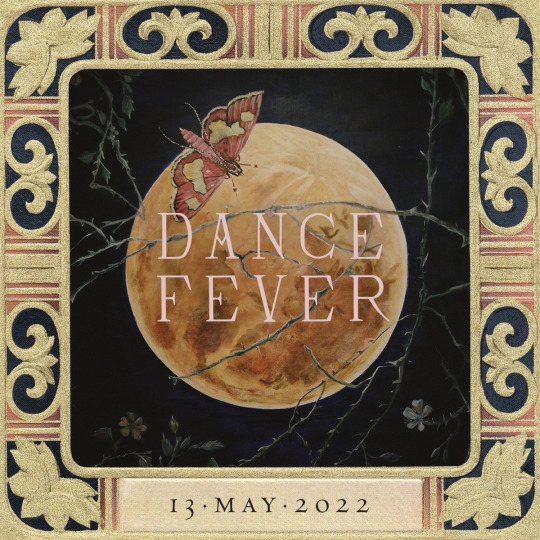
So it was ‘My Love’ that really sealed the deal for me, as I was coping with the grief of an ex colleague ghosting on me-I played that song too religiously everytime it is on my spotify or my old-ass iPod. It has painful lyrics wise, but the music is upbeat (Similar to Mitski’s Laurel Hell, which I liked)
She released her tagline of her album as ‘A fairytale in 14 songs’ which is such a cool premise as Florence said about a woman and her relationship with ‘performing’, which deal with societal pressures and all. And I think that story dealt with that expectations of others and how to break away is felt through in this story
In fact I chatted with Danica that one of her songs “Dream Girl Evil”, was my theme song for Midoriko when she shared her head canon on how they met, which I wrote the idea of the field, bopping to that song over and over again, which bleeds through the story which Midoriko do not want to be perceived as that ‘goddess’ and ‘holy’ figure but a human, and yet she is planted to that perception, the lyric- “I am no Mother, I am no Bride, I am king” is bled into Kirinmaru calling Midoriko his king-not only adding to the fairytale aspect of it, but it is subverting gender roles which is fitting for our couple, ‘My Love’ fits all of the emptiness Kirinmaru felt being trapped by all.
It was that strange little fairytale-esque album which bleeds through the whole story, which you can see in its veins, which I hope you get to listen to it.
#cat chats about I want you#Fanfic: I want you#florence + the machine#Florence and the machine#Florence Welch#Dance Fever#writing#writers on tumblr#Spotify
0 notes
Note
also........if ur characters were a pokemon, what would they be?
hmmmm. theres probably gonna be some overlap between this and their partner pokemon, but
laurel is a noivern. edgy sound pokemon. c’mon. im sure laurel-1 was some kind of bird
maive is a houndour. i debated between a lot of fire pokemon, and canines, but... i think the fact that houndoom has a mega really seals it. maive would be someone with a mega form.
maria is a mimikyu. the other option would be a shedinja, to be more literal, but...
actually, i feel like mothpaw would be a deerling? normal/grass fits her really well
you know what? nyssa is a nidoqueen. she should be something a little faster or more sneaky, but i feel like the... meta of nidoqueen fits nyssa’s arc better
ivypool is an umbreon, with the caveat that dovewing is an espeon. i mean, cmon, it just works!
veronica is a linoone. a furret might’ve worked, but i like the lore of linoone running in straight lines and has to stop to turn. that feels appropriate for how she can get... blinders, sometimes. (veronica voice) running is the only thing i do straight
winter is a lapras! actually i was gonna have some other reasons, but apparently lapras can understand human speech, and i feel like that fits for his interest in humans. yes
and then a potential, ferrosia is a druddigon! powerful type, but stuck with no evolution and no real focus
3 notes
·
View notes
Text
Harry Styles twirls in the center of the floor of the L.A. Forum, dancing wildly to his new song “Golden.” The venue is deserted. It’s Thursday afternoon, just a few hours before the release of his hotly awaited second album, Fine Line. He’s rehearsing for Friday night’s big album-release celebration show. (Outside the arena, the parking lot is full of tents — fans from around the world have been camping out all week, awaiting a spot on this floor.) After a few hours of rehearsing with his band, Styles cuts loose as the new album begins to blast over the speakers, breaking into a dance of joy. It’s probably the last time he’ll ever hear this song in a room where nobody else is dancing.
Backstage, he lounges on a leather couch in his corduroy flares, a string of pearls, and a yellow T-shirt depicting a panda and the words “I’m Gonna Die Lonely.” He and his musical wingman, Tom “Kid Harpoon” Hull, argue over the set list for the upcoming world tour, even though it doesn’t start until April. His mother reaches for an apple; ever the dutiful rock-star son, Styles directs her to the bowl where the tastier apples are hidden. He’s restless with anticipation for the world to hear his new songs, and he’s not doing a great job of hiding it.
Fine Line is the soulful, expansive, joyous pop masterpiece Styles has been reaching for ever since he blew up nearly 10 years ago, as the heartthrob of One Direction. As he sings in “Lights Up,” the single that dropped in September, he’s stepping into the light. “It all just comes down to I’m having more fun, I guess,” he says. “I think ‘Lights Up’ came at the end of a long period of self-reflection, self-acceptance,” he says. “Through the two years of making the record I went through a lot of personal changes — I just had the conversations with myself that you don’t always have. And I just feel more comfortable being myself.”
His life has changed in oh-so-many ways — some involving the occasional magic mushroom, others involving the even more psychedelic power of a broken heart. The music ranges from the Laurel Canyon hippie soft-rock vibe of “Canyon Moon” — Styles calls it “Crosby, Stills, and Nash on steroids” — to the R&B pulse of “Adore You.” Fine Line is a breakup album that’s often sorrowful but reflects the introspective evolution of a 25-year-old navigating the seas of having sex and feeling sad, despite Styles having spent so much of his youth in the spotlight. He’s refusing to follow trends or fit any formula. “The overall arc is just that I tried to redefine what success means to me. I tried to rewire what I thought about it. A lot changes in two years, especially after coming out of the band and just working out what life is now. I feel so much freer, making this album — you get to a place where you feel happy even if the song is about the time when you weren’t that happy.”
The first time Styles played this album for me, back in June, it was a few miles away, in L.A.’s Henson Studios, the same room where his idol Carole King made Tapestry — for him, sacred ground. “I look back on the last album,” he said then, referring to his 2017 solo debut. “And I thought I was being so honest, just because there’s one line about having a wank. I had no idea. You write a song that’s pretty open and honest, and you think, ‘That’s just my song,’ but then you hand it over to people, and it’s like, ‘Oh fuck!’ Until people hear them, they’re not even songs. They’re just voice notes.”
Here is Styles’ song-by-song guide to Fine Line — along the creative and emotional journey he took while making it.
“Golden”
The first song written for Fine Line, on the second day of the sessions at Shangri-La Studios in Malibu. “That was always the first one I played to people,” he says. “That was just always going to be Track One.” It’s a blast of vintage Seventies SoCal soft rock, the kind of Laurel Canyon mellowness that suffused his first album, layered in guitars and harmonies. “When we wrote ‘Golden,’ we were sitting around the kitchen in the studio, and I was playing it on guitar. There were five of us singing the harmonies — the acoustics in the kitchen made it sound so cool, so we thought, this song’s gonna work.”
Even in this sunny SoCal pop tune, there’s a tinge of bittersweet loss: As the sun goes down, he pleads, “I don’t wanna be alone.” As he says, “I don’t know much about Van Morrison’s life, but I know how he felt about this girl, because he put it in a song. So I like working the same way.”
“Watermelon Sugar”
Styles did this fruit-crazed jam on Saturday Night Live, stretching out with his live band. He wrote “Watermelon Sugar” with producer Tyler Johnson, Tom Hull, and guitar sidekick Mitch Rowland; as with the whole album, he worked with members of his tight rotating cast of friends and collaborators, rather than the usual hit squad of pros. “If you’re going in with session writers or something, you spend one or two days there, and there is no way that person really cares about your album as much as you do. Because they’re into something else tomorrow. I know that Mitch, Tyler, Tom, Sammy [Witte], Jeff [Bhasker] wanted the album to be as good as I wanted to be. They don’t care if it’s their song or not. They’re not concerned how many songs they get on an album. They want it to be the best album it can possibly be. We’ll bond over music we love and things we’re going through. It’s not like there’s one person in the group that’s like, ‘Well, no, I don’t talk about that. I just make beats.’”
A massive influence on the album — and on his life — is his experience on his first solo tour, stepping out without One Direction. “The tour, that affected me deeply. It really changed me emotionally. Having people come to sing the songs. For me the tour was the biggest thing in terms of being more accepting of myself, I think. I kept thinking, ‘Oh wow, they really want me to be myself. And be out and do it.’ That’s the thing I’m most thankful for, of touring. The fans in the room [make] this environment where people come to feel like they can be themselves. There’s nothing that makes me feel more myself than to be in this whole room of people. It made me realize people want to see me experiment and have fun. Nobody wants to see you fake it.”
“Adore You”
“‘Adore You’ is the poppiest song on the album,” he says of the latest single. “This time I really felt so much less afraid to write fun pop songs. It had to do with the whole thing of being on tour and feeling accepted. I listen to stuff like Harry Nilsson and Paul Simon and Van Morrison, and I think, well, Van Morrison has ‘Brown Eyed Girl’ and Nilsson has ‘Coconut.’ Bowie has ‘Let’s Dance.’ The fun stuff is important.”
“Lights Up”
After kicking off his solo career with “Sign of the Times,” a sprawling glam-rock piano epic, Styles surprised many fans with his first single from Fine Line: a succinct, sleek R&B groove. “When I played it for the label, I told them, ‘This is the first single. It’s two minutes, thirty-five. You’re welcome.’” It came late in the sessions: “Lights Up,” “Treat People with Kindness,” and “Adore You” were written in the final week this spring, in a burst of inspiration.
For Styles, it has something to do with stepping out on his own. When he began songwriting, it was as a member of the group. “‘Happily’ was the first time I saw my name in the credits. I liked that,” he says. “But I knew I’d only sing part of it. I knew if I wrote a really personal song, I wouldn’t sing it. It was like a safety net. If a song was too personal, I could back away and say, ‘Well, I don’t have anything to do with it.’ The writing was like, ‘Well, if I was going to write a song about myself, I’d probably never sing it.’ It’s like storytelling. Sometimes if you’re, like, telling a really personal story, then the voice changes every few lines; it doesn’t quite do the same thing. As the songs got more personal, I think I just became more aware that at some point there might be a moment where I would want to sing it myself.”
A turning point was “Two Ghosts,” a ballad from his solo debut. “’Two Ghosts’ I wrote for the band, for Made in the A.M. But the story was just a bit too personal. As I started opening up to write my more personal stuff, I just became aware of a piece of me going, ‘I want to sing the whole thing.’ Now I look at a track list and these are all my little babies. So every time I’m playing a song, I can remember writing it, and exactly where we were and exactly what happened in my life when I wrote it. So the whole show is this massive emotional journey, you know? That’s a big difference, rather than every 20 minutes you go, ‘Oh, I remember this one.’”
“Cherry”
The most powerful moment on Fine Line — a raw confession of jealousy. His engineer Sammy Witte was playing an acoustic guitar riff that Styles overheard and loved. “That was the moment of saying, ‘Yeah, I want my songs to sound like that,’” he says. It ends with a female voice speaking French, while Harry jams on guitar. “That’s just a voice note of my ex-girlfriend talking. I was playing guitar and she took a phone call — and she was actually speaking in the key of the song.”
“Falling”
A dreamy soul ballad. “Tom had come up to my place to grab something, and he’d sat at the piano and I’d just got out of the shower. He started playing, and we wrote it there. So I was completely naked when I wrote that song.”
“To Be So Lonely”
“The song ‘To Be So Lonely’ is just really like the articulation of Mitch’s brain,” Styles says. “Even when Mitch plays to himself, he’s got the swing.” The song was composed on a guitalele — a ukulele with six strings. “They’re really good for writing on, because you can travel with them. I had one of those with me in Japan, so they’re really good for spur-of-the-moment ideas.”
“She”
A fantastic six-minute rock epic with a loopy guitar excursion, as if Prince circa “Purple Rain” jammed with Pink Floyd circa “Shine On You Crazy Diamond.” “Mitch played that guitar when he was a little, ah, influenced,” Styles says. “Well, he was on mushrooms, we all were. We had no idea what we were doing. We forgot all about that track, then went back later and loved it. But Mitch had no idea what he did on guitar that night, so he had to learn it all over from the track. That one to me feels really British. I usually sing with a slight American twang, because the first person I ever listened to was Elvis Presley. When I’ve been doing the track listing, and ticking off the ones to definitely make the album, it’s always in the first three to be ticked. That’s a phenomenal song.”
“Sunflower, Vol. 6”
An experimental trip with “deep cut” written all over it: “I would love people to listen to the whole album. I want people to listen to every song. Even with streaming and playlists, I love listening to records top to bottom. So I want to make make albums that I want to listen to top to bottom, because that’s just how I listen to music.”
“Canyon Moon”
“I was in a pretty big Joni hole,” Style admits. Inspired by his Southern California surroundings — and his obsession with Joni Mitchell’s 1971 classic Blue — he tracked down Joellen Lapidus, the woman who built the dulcimer Mitchell plays throughout that album. Back in the day, Lapidus introduced Mitchell to the wonders of the mountain dulcimer; she took it backpacking around Europe and wrote some of her most classic songs on it. Styles and Tom Hull got their first lesson in the instrument from Lapidus herself, at her house in Culver City. He proudly calls this song “Crosby, Stills, and Nash on steroids.” When he played Fine Line for Stevie Nicks this summer, she picked this as her favorite — and as you may know, Stevie’s opinion means a lot to the young man she called “my little muse Harry Styles.”
“Treat People With Kindness”
This up-with-people singalong doesn’t sound like anything else on the album. It began after the slogan was featured prominently on Styles’ first solo tour: “I told Jeff, I would love to someday write a song called ‘Treat People With Kindness.’ And he was like, ‘Why don’t you just do it?’ It made me uncomfortable at first, because I wasn’t sure what it was — but then I wanted to lean into that. I feel like that song opened something that’s been in my core.”
“Fine Line”
The longest and most eccentric song on the album — one of the first to be written, as a simple folky ballad, but it kept expanding and evolving. “It’s a weird one,” Styles says. “It started simple, but I wanted to have this big epic outro thing. And it just took shape as this thing where I thought, ‘That’s just like the music I want to make.’ I love strings, I love horns, I love harmonies — so why don’t we just put all of that in there?” It typifies the spirit of the whole project. But he knows he can’t please everyone. “When my granddad first heard ‘Lights Up,’ he was, ‘Yeah, I had to listen to it a couple times to get it. But I’m just glad you’re still working.’ It was funny, but I thought, I’m just glad I’m still working.”
0 notes
Text
Laurel, Yanni and McGurk: Why your life is a lie
Update: I’m not dead! I know I haven’t been posting regularly. I’m sorry. It’s down to two things really: a) I’ve been very busy with the new job and b) I’ve frankly really struggled to find any kind of inspiration lately - I suppose that’s what happens when your life is taken over by your job. And you’re an auditor.
But this week this whole Yanni/Laurel brought about a bit of a brainwave - not least because it’s done nothing but do my nut in. Literally every one of my social media feeds is infected with these words. Apart from Twitter - but only because it contains an option to mute words - but even then I’m still swamped by the overhyped, equally annoying sequel: green needle/brainstorm.
However, as with most things I hate, I’m going to put my back into this.
A few things are going to happen in the next few minutes: we’re going to unpack the explanations behind these phenomena, and then I’m going to try to shatter your perception of the world.
The Yanni/Laurel thing has now been confirmed as an aural phenomenon: if you were to plot the frequencies present in the recording against time, much like something you’d get on Audacity or any other kind of audio-editing software, you would see that this clip is made up of a mixture of high and low frequency tones. Yanni is formed from the higher frequencies. Laurel is characterised by lower frequencies. It’s like listening to what are essentially two different tracks of music that have been overlaid. If your ear is more attuned to higher frequencies (perhaps the younger among you), or you’re the kind of animal that turns down the bass on your speakers, you’re going to hear Yanni. The vast majority of people however hear Laurel, because, well, we’re older.
Now we come to Laurel’s little sister: green-needle/brainstorm. She’s a little smarter, a tad more interesting and she was allowed to wear makeup from a younger age. What you can hear in this recording can be changed depending on simply the word you’re looking at when you hear it, which is much more than a physical phenomenon - it’s a psychological one. We know something to be true - that we’re hearing the same sound each time, but our perception of it changes. This is interesting for two reasons: firstly, on a psychological level it helps us to dissect how our brains work, and secondly, more importantly, it proves to us that objective truth is a fallacy.
Green needle/brainstorm is a slightly more evolved example of the McGurk effect, which is a widely known and studied phenomenon where your brain can interpret the same audio/visual recording as two different sounds depending on the context it’s given. This context often comes in the form of a visual cue, which is much better explained by the folks at Horizon: https://www.youtube.com/watch?v=G-lN8vWm3m0. Ultimately it comes about because of the top-down processing in our brains. What does this mean? Well, effectively our brains process a whole load of information all at once, and uses its analysis of this to work out the most probable explanation of our current circumstances to make sense of the world. For example, imagine you’re on safari. There’s not a cloud in the sky, you’ve got the sunroof down and you’re driving through a woody looking area. You hear a dense flock of startled birds swiftly fly out of the branches above you as your jeep slams through the undergrowth. They’re so close you can feel the beat of their wings in the air around you, and suddenly you feel something cold drip onto your hair and down your neck.
You’ve surely been shat on.
You look up and see a monkey peering down at you from the sunroof, drooling.
But for a second, you believed you’d been shat on, well, because you hadn’t noticed the monkey. Hey, we’re not perfect.
Additionally your analysis often relies on the outcomes of events that it’s seen before and it projects these probabilities on the current situation in order to work out what’s going on. For example, if you’ve had a horrid cough before and went to the GP, who told you it was pneumonia, the next time you get a cough you’re more likely to think it’s pneumonia again, even though that’s actually quite unlikely. The McGurk effect combines these two analytical phenomena. Most of the time you hear a hard “k” sound and seen a particular mouth shape, it’s turned out to be a word starting with that letter. But if that same exact sound is accompanied by a “g” mouth shape, your brain goes “Well, based on past experience, that word must begin with a G”.
TLDR: we can easily trick ourselves, and others based on the subset and quality of information we allow ourselves to see.
As well as being a fun illusion, like all other illusions it highlights something more insidious: we’re all primed for bias - it’s inherently how our brain deals with the mound of information it receives every single millisecond of every day. If we didn’t skip straight to conclusions we’d end up overthinking everything and ultimately not taking any action. Evolutionarily speaking, our ancestors would have died if they didn’t spring into action on hearing twigs breaking, assuming it was indicative of an imminent attack. The benefit of catching our predators pre-arrack vastly outweighed the excess energy expended on false alarms. Out of our ancestors, those who were the quickest to leap into action on hearing the quietest of sounds lived the longest. However, in modern day terms this kind of cranial processing doesn’t work as well. Sure, based on he gait of the person in front of you at Kings Cross, you might predict they’re going to take a hard swerve left to the Victoria line and you can use that information to prevent an embarrassing collision. I’m not saying this fundamental system of processing doesn’t have its merits - I’m just saying it has fewer: we don’t spend every waking moment fending off predators any more, because we’ve built infrastructure, terraformed land, driven predators out of their natural habitats and evolved societies that provide you with security against dangerous individuals in return for a cut of your income.
So we find ourselves in conflict. We have brains that are used to using whatever information is conveniently available and pre-existing knowledge to judge, but vastly reduced the need for that judgement. We’ve also reduced the benefits of this judgement - if anything it’s often frowned upon. We’ve developed a new term for unnecessary judgement: prejudice. And we often think we’re well aware of our own prejudices and can therefore escape them - but I’m here to tell you that the vast majority of us can’t. Take this for example:
Try to memorise these words:
Adventure, curious, sun, brave, clean, friendly, ocean, white, fruit, learn, free, wholesome, holiday, talented.
Now read this:
Alan is making plans for his gap year. He wants to visit the South America but is struggling to fit that in with his plans to take part in a motorcross rally. He missed it the year before because he broke his leg in the practice round. He needs to find his passport, which he lost on his last trip back from Bali and hopes his friend accidentally picked up. He also wants to visit India and needs to find time to move into his flat in Camden before he starts at his London uni.
What do you think of Alan?
What would you have thought had you memorised these words instead:
Jealous, green, selfish, cocaine, petty, reckless, red, corrupt, idiot, lad, careless, clown, rude.
Go back and read the paragraph again - see what you think.
He might have seemed a bit of a gap yah wanker that time, methinks.
This is something called priming, which is an extension of the broken thinking we discussed earlier. It’s exactly how advertising works - we can’t help but associate things together when they’re close together, either spatially or temporally. You judged Alan because those lists of words made you linger on different sets of details in the narrative each time. If you start to form an opinion, you’re more likely to see details that reinforce them.
So what’s my point? I’ve just shown you that this kind of thinking is inescapable: you knew where this article was going and yet you likely painted a picture of two different Alans. I’ve told you that our brains are hard-wired for bias. That our perception of the world is inherently, inescapably warped. That we all have our blind spots. That we can convince ourselves of anything depending on what details we choose to notice. And that our choices of details are rooted in past experience. The logical conclusion of this is that as we get older, we get more biased. Something happens, we learn from it, maybe even form a slight opinion, we stumble across varied details in the subsequent hours, days, weeks of our lives, and out of these details our brains are primed to pick out those that are familiar, opinions and beliefs are justified and strengthened, our filter for details gets narrower, our opinion gets stronger, our blinkers come down even more, so on and so forth. Incidentally it’s eerily similar to how evolution works.
We’re built from bias.
This means that in order to even be able to grasp at objective truth, you have to work. Really work. Hard. And I think this is something that is totally overlooked in our current political climate. We all think that facts are facts - they’re not, simply by virtue of being beheld by us. We, these flawed, inherently biased networks of synapses in cages of bone and bags of skin. But we need to guard against this. No man is an island, and as a society we need to believe in the concept of objective truth, even if we accept we’ll never achieve it. If we don’t, we lose our baseline for discussion, leading to a society which is unable to sort opinion from fact: one in which radical, absurd and harmful ideas could propagate at the same speed as those more closely aligned with common sense, driven by whimsy. Truth is the tare weight for any battle of wits - without it, there could be no consensus.
So if we must believe in an objective truth, but can only ever see it through a glass, darkly, so to speak, how can we polish the lens?
This brings us full circle to audit, my bread and butter, and perhaps why the question of truth is at the front of my mind. Audit is fully preoccupied with objectivity and truth - firms drop clients and lose money because of it all the time. This is because our job is to take the draft financial statements a company prepares before they’re published and ensure that the figures in them haven’t just been made up, or tweaked. We need to assess whether the numbers show an adequately “true and fair” view of what’s happened to that company during the year. As with everything, we can never be 100% certain of the truth, or fairness of accounts, so we test the numbers to a reasonable level of assurance.
Believe it or not, there are a couple of aspects that are quite interesting about it:
Firstly, sampling. Much like biologists attempting to study animals in a large habitat, the feat of fully auditing every single transaction a company makes during the year is nigh on impossible. Instead we choose a representative sample of transactions and look at those in more detail to work out if they were recorded correctly. We’re always terrified of choosing the wrong number of transactions - if we audit too few, we might miss one large one which was fraudulent or recorded wrongly - one typo could change an overall profit to a loss. If I wasn’t thorough enough, I could lose my job over that.
Secondly, we rely heavily on the people running the audited company to tell us what happened during the year. If for example they failed to tell us that they underwent a huge merger, we might audit them against the wrong set of financial standards. We might think it’s all fine by those standards - but that’s a false positive. We used the wrong measure of truth, because we didn’t have all of the facts.
So why did I bother to tell you all this?
Because auditors measure truth for a living, and you might learn something from the highly discussed and regulated procedures we use day in, day out. The next time you find yourself judging something - anything, for that matter, however small - ask yourself these questions:
How much detail can I subtract from the situation before I change my view of it?
Is there a detail or perspective I’m missing because I’m being primed by my prior beliefs, assumptions or experiences?
If you find the threshold for Q1 and an example for Q2, you’ll be much closer to the truth than you were before.
You never know, you might end up finding truth in the most unlikely of places, and applying measured skepticism can lead to some of the most - sometimes surprising - eye-opening revelations. Those “MY LIFE HAS BEEN A LIE” moments. Never be afraid of disagreeing with your past opinions - it’s a sign of learning.
Some great resources:
On the illusion of pain, and how the perception of context guides belief: https://www.youtube.com/watch?v=-3NmTE-fJSo
On humans as slightly wonky bipedal brain machines: Kluge - The haphazard evolution of the human mind, Gary Marcus
#yanni#laurel#green needle#brainstorm#illusion#truth#trump#politics#objectivity#philosophy#psychology#mcgurk#what do you hear#original#snaprevise
3 notes
·
View notes
Text
Birthday Reflections of a Year in Lockdown
By David Himmel
I read a meme or a post or some kind of thing on the Faceborg the other day that said, “Tradition is just peer pressure from dead people.” It struck me because, like many of us, tradition was a big thing in my house growing up. Often used as a guilt magnifier to help hone good behavior. And I like it because if this past year has showed us anything it’s that the only tradition really worth maintaining for whatever possible reason is change.
Things change. Things need to change. Evolution > Tradition.
That said, I also like the tradition I lifted from Don Hall, which is to write an essay on one’s birthday about the things one has learned on their most recent trip around the orange fireball at the center of our lonely little solar system. And Don Hall is not dead. Yet. So, I guess this is less tradition and more, um, inspired peer pressure.
I’ve been at this shit for forty-two full years now. It’s been mostly fun. There were those three years at the tail end of my twenties that nearly killed me but I came out of them with a novel and the ability to shoot tequila. So, you know, win. And, I managed to forge a few really solid friendships despite the alcoholic and depressed cloud that surrounded me much like Pig-Pen’s cloud of dirt. I’m long past those Dark Days, and yet, I still manage to bring them up in casual conversation or pre-dawn essay writing. And that is a perfect way to dive into the things I’ve learned this past year.
I am extremely and arguably absurdly emotionally attached to things
This is more of a reminder, or a reinforcement of what’s blindingly obvious to me. This personality quirk—or defect, depending on who you are and how you choose to look at me—is flexing pretty hard right now as we plan to move from this apartment of eight years to a new house in a new Chicago neighborhood. Moving is the perfect time to purge and I’m just not sure I can bid farewell to things I know I’ll have to leave behind. Yeah, yeah, I know all about the Marie Kondo thing of items sparking joy. But I go one deeper: Keep items that spark reference. Maybe I should have been a museum curator instead of a writer and creative director. Because to me, just about everything is worthy of historical preservation. That includes a pair of boxer briefs I bought over twenty-one years ago. (More on that in another forthcoming essay.) It’s not that I’m incapable of throwing things out, it’s just that it’s harder for me than most. But when I reach the stage of acceptance that some history is best preserved in one’s mind and the time comes to put something behind me or on the curb, I do so with abandon and a swiftness unmatched. Done is done. Maybe I’ll write about it. Maybe it’s the next novel.
Writing takes a different kind of energy now
When the idea of being a writer was a goal, I could churn out typed pages for days all while wearing a big smile on my face. Then I started to get paid for it. Then work got busy. Then the kid woke up. Then the dog had to go out. Then… then… then… I’ve spent the last year or so retraining myself to be a writer. Yes, I can still do it and I do, but it has since come to feel like another responsibility, another piece of accountability I lug around like Marley’s chains. Inspiration fits differently on this overtly domesticated body.
I really like He-Man
But not in the gay way. Although there’s nothing wrong with that. The Masters of the Universe was my favorite cartoon and my favorite toys when I was only slightly older than my son is now. This year, Mattel released all new Masters of the Universe origin figures. I saw He-Man and Skeletor hanging on a shelf in Target one day and just about lost my mind. These figures are now fully poseable and, well, I needed them. I took a photo and sent it to my good friends Dr. Jarret Keene and Don Hall teasing them with, “My birthday is coming up!”—it was, like, February. The next day, an Amazon box arrived at my place. In it was He-Man, Skeletor, and fucking Battle Cat! Jarret sent me an early birthday present. Do I play with these things? Yep! It’s a great way to procrastinate. It completely removes my mind from the work at hand, the horrors of the news, and the blood-boiling stupidity of social media’s doom scrolling.
Shortly after I received these toys, I realized that He-Man has been a constant all my life. I own the entire series on DVD and have for decades. My favorite dish in the house is a plastic Masters of the Universe plate that’s older than my baby brother and is completely dishwasher safe. I have a Lordi band t-shirt stylized like the Masters of the Universe logo. I still think Evil-lyn is hotter than Teela, and I’ll argue to my death that the 1987 live-action Masters of the Universe film starring Dolph Lundgren and Frank Langella as He-Man and Skeletor respectively is the greatest project Courtney Cox has ever participated in. Speaking of…
Friends still sucks
The jokes, most storylines, and character developments beyond season four do not hold up. It’s almost like those episodes were written by out of touch white baby boomers. Oh, yeah, they were.
I need to pause and be proud of myself every now and again
I’ve never been one to rest on their laurels. And I’ve never been one for daily affirmations or being really proud of making little steps toward a big goal. I’m not that shallow or weak. But being asked to write for The Atlantic and the President of the United States is pretty cool—and kind of a big deal.
Our marriage should be good
There’s never really a good time for anyone to put their marriage on coast, but I think we’ll be okay. At least for a little while, the need to panic over the state of our affairs is behind us. Katie and I managed to get through (most) of a global pandemic going into it a little burned out from parenthood and personal failings, but here we are, getting along better and generally pretty excited for the future of things. Maybe Katie has a different perspective on things. I don’t know. We don’t talk much.
I do have Hollywood looks
Despite how much I dislike my big nose and my twisted, bony frame, I always felt I was at least mostly good looking. Maybe even good looking by Hollywood standards. Tell me I don’t look like Adrian Brody or Steve Carrell or Mr. Bean or the new Elliot Page. I swear, I saw this photo of Page and my first thought was, “Holy shit, Elliot page has a picture of me in a Las Vegas pool in 2003. That’s weird.”
I’ve become almost perfectly comfortable with my discomfort with my American Judaism
Too much to unpack right here right now. But I’m confident by age forty-three, I’ll have no problem telling American Zionists to fuck themselves in the face with an Uzi with the same passion I’d tell a Trump-supporting, Capitol-storming racist to fuck themselves with their stupid Confederate flags.
Paying attention pays off
It’s easy to pay close attention to my son growing up. That’s the warning everyone gives new parents: pay attention because the time goes by so fast. I keep a good eye on the kid and his development and I try to appreciate all of the little moments. Thankfully, I have the Literate ApeCast as a solid documentation of this very thing. But paying close attention to your children makes it real easy to forget about yourself. And your partner. I’ve had to learn to pay better attention to everyone’s development in my household. Myself included. Keeping one eye on yourself helps keep you grounded, focused, and on task to be the Master of the Universe just like you always wanted to be.
Keep going, kid, you’re not an old man yet.
0 notes